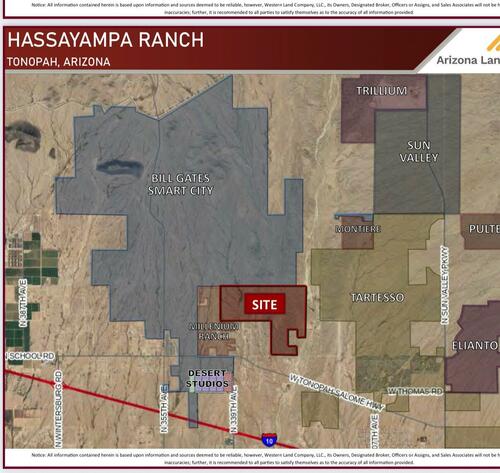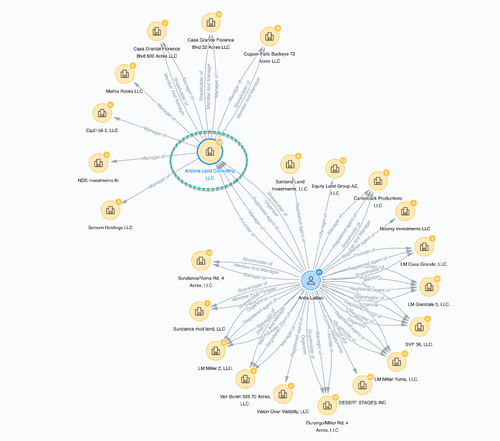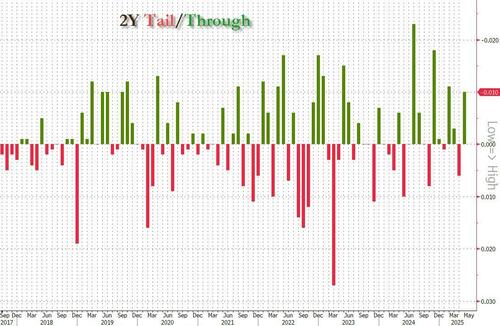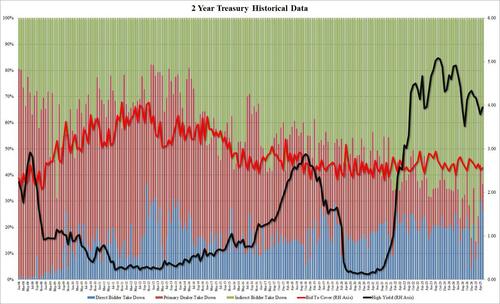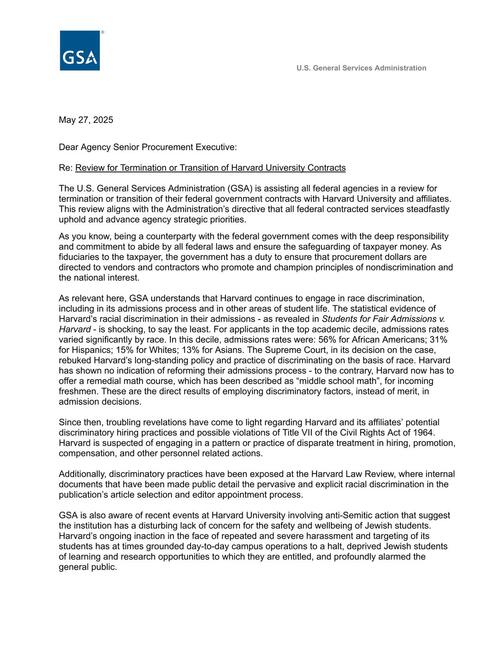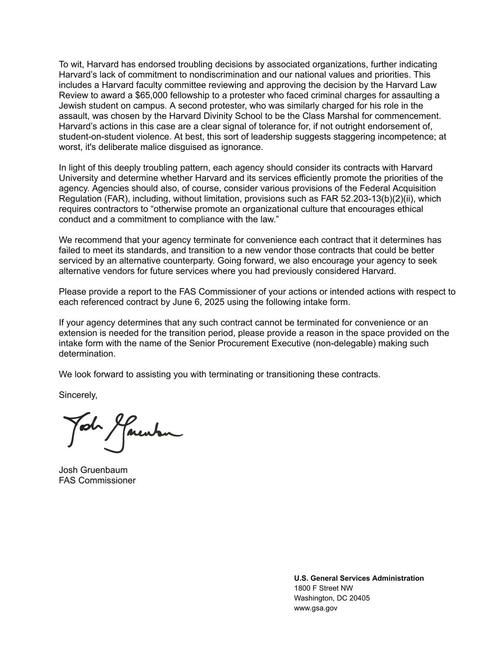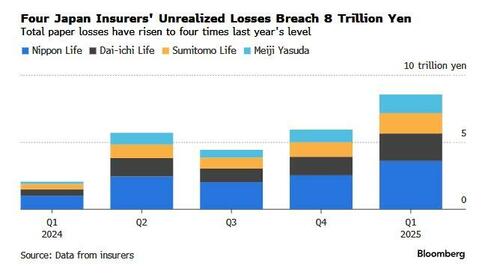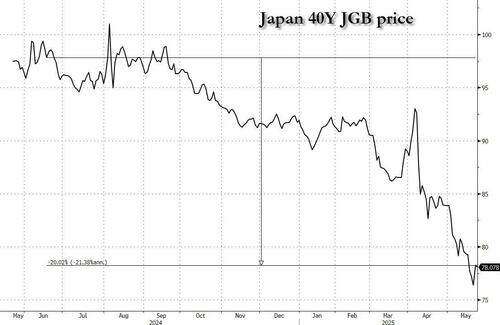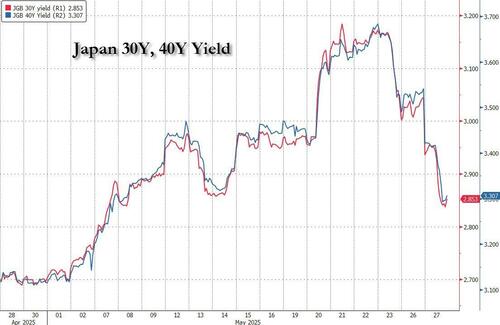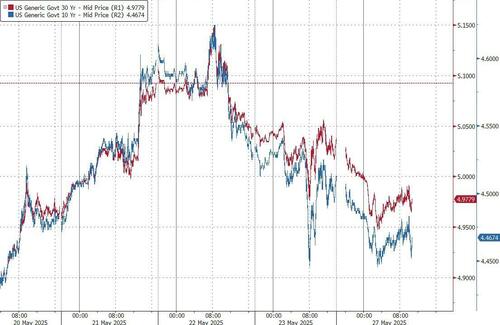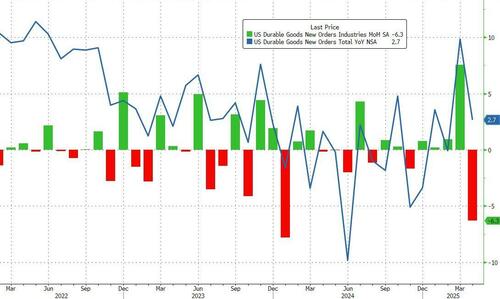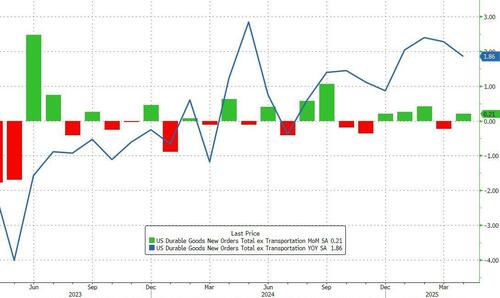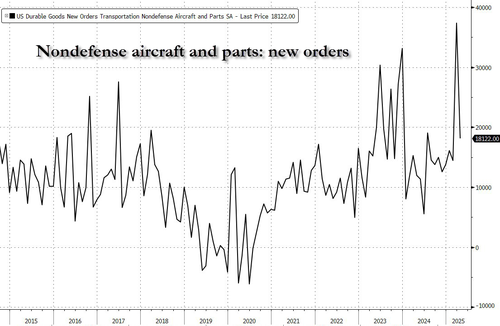In proclaiming the faith and in administering the sacraments every priest speaks on behalf of Jesus Christ, for Jesus Christ.
Distinction Matter - Subscribed Feeds
-
Site: Zero HedgeWatch: Footage Shows Activist Judge Helping Illegal Immigrant Avoid ICETyler Durden Tue, 05/27/2025 - 15:45
Authored by Luis Cornelio via Headline USA,
Milwaukee County has released security footage of a state judge allegedly helping an illegal immigrant evade an ICE arrest on April 18.
The video, obtained through an open records request according to WISN12, shows Mexican national Eduardo Flores-Ruiz being guided through a back door of a courtroom just as federal agents waited to arrest him.
The judge, identified as Wisconsin’s Hannah Dugan, is seen confronting the ICE agents after a court official alerted her of their presence.
The video shows Dugan speaking with the agents seated outside her courtroom, directing them to the chief judge’s office after reportedly disagreeing over the type of warrant needed for the arrest.
OBSTRUCTION: Judge Dugan needs jail time for her crimes. pic.twitter.com/NofAUjZDfC
— @amuse (@amuse) May 23, 2025Shortly thereafter, Flores-Ruiz appears walking with his attorney down the same hallway.
They walked past a plainclothes agent, who then proceeded to follow them at a distance.
Another camera angle shows Flores-Ruiz exiting the building through a basement doorway typically used by jurors.
The agents Dugan sent to the chief judge’s office were later seen leaving and heading toward the exits.
As Flores-Ruiz exited the building, agents rushed to intercept him but had to run to catch up as he fled on foot.
Seconds later, agents tackled and arrested him in a scene that looked straight out of a movie.
Flores-Ruiz had been deported in 2013 but reentered the United States at an undisclosed date. He was subject to an administrative arrest warrant from ICE following his state-level domestic battery charges.
Dugan is now charged with obstruction of proceedings before a department or agency of the United States and with concealing a person to prevent arrest.
“The Department of Justice will continue to follow the facts - no one is above the law,” Attorney General Pam Bondi said in a press statement announcing Dugan’s charges.
-
Site: Zero HedgeWatch: Footage Shows Activist Judge Helping Illegal Immigrant Avoid ICETyler Durden Tue, 05/27/2025 - 15:45
Authored by Luis Cornelio via Headline USA,
Milwaukee County has released security footage of a state judge allegedly helping an illegal immigrant evade an ICE arrest on April 18.
The video, obtained through an open records request according to WISN12, shows Mexican national Eduardo Flores-Ruiz being guided through a back door of a courtroom just as federal agents waited to arrest him.
The judge, identified as Wisconsin’s Hannah Dugan, is seen confronting the ICE agents after a court official alerted her of their presence.
The video shows Dugan speaking with the agents seated outside her courtroom, directing them to the chief judge’s office after reportedly disagreeing over the type of warrant needed for the arrest.
OBSTRUCTION: Judge Dugan needs jail time for her crimes. pic.twitter.com/NofAUjZDfC
— @amuse (@amuse) May 23, 2025Shortly thereafter, Flores-Ruiz appears walking with his attorney down the same hallway.
They walked past a plainclothes agent, who then proceeded to follow them at a distance.
Another camera angle shows Flores-Ruiz exiting the building through a basement doorway typically used by jurors.
The agents Dugan sent to the chief judge’s office were later seen leaving and heading toward the exits.
As Flores-Ruiz exited the building, agents rushed to intercept him but had to run to catch up as he fled on foot.
Seconds later, agents tackled and arrested him in a scene that looked straight out of a movie.
Flores-Ruiz had been deported in 2013 but reentered the United States at an undisclosed date. He was subject to an administrative arrest warrant from ICE following his state-level domestic battery charges.
Dugan is now charged with obstruction of proceedings before a department or agency of the United States and with concealing a person to prevent arrest.
“The Department of Justice will continue to follow the facts - no one is above the law,” Attorney General Pam Bondi said in a press statement announcing Dugan’s charges.
-
Site: Zero HedgeChamath Palihapitiya Unveils Plans For AI Data Center Near Bill Gates' Arizona Smart CityTyler Durden Tue, 05/27/2025 - 15:25
Industry insiders—particularly those on the financing side of AI data centers—describe to Zero Hedge the current buildout as a "sprint" expected to continue through President Trump's second term.
Last week, we covered the major development in Abilene, Texas—a massive data center project widely considered the first "Stargate" project under President Trump's broader AI infrastructure initiative.
Backed by Crusoe and Blue Owl Capital, the Abilene facility will be operated by OpenAI—the creator of ChatGPT—positioning it as a flagship project in President Trump's effort to rapidly scale U.S.-based AI infrastructure amid an intensifying AI race with China.
Adding to the wave of data center investment news, Chamath Palihapitiya, CEO of Social Capital, wrote on X in response to CAPITAL.news, "We're going to build a 1 GW AI data center in Arizona," signaling another major deal to expand US AI infrastructure.
Announced this today! We’re going to build a 1 GW AI data center in Arizona.
— Chamath Palihapitiya (@chamath) May 27, 2025
I’ve never done a RE deal so working with a great RE investor, @anitavlallian, with a vision for the project was key. Anita is a star.
Ultimately this will require us investing $25B to get the entire… https://t.co/GqSVPSJeO3 pic.twitter.com/XWYFPldg5JPalihapitiya said this is his first real estate deal, noting that he partnered with Anita Verma-Lallian, CEO of Arizona Land Consulting (ALC), and other investors to purchase 2,100 acres of land west of Phoenix, known as Hassayampa Ranch.
Key points of the deal:
-
Anita Verma-Lallian's ALC is spearheading the data center land deal.
-
Palihapitiya is backing the project as a sign of growing investor interest in AI infrastructure.
-
The deal involves land that can support over 1GW of power—ideal for a cluster of data centers.
-
This is ALC's second major transaction involving large-scale, ready-to-build real estate aimed at tech infrastructure.
-
Verma-Lallian frames the investment as a historic milestone in the race to secure America's AI future, drawing parallels to Bill Gates' previous land deals in the region.
"We own 2000 acres right beside Bill Gates' smart city and down the road from a nuclear reactor," Palihapitiya emphasized.
He continued, "Now we continue the process of entitlements and regulatory permitting so we can start construction."
According to publicly available records, Verma-Lallian is listed as the founder of ALC, which manages a number of real estate deals.
As one industry insider put it, data center development is now in "sprint" mode—and we expect the pace of deal announcements to only accelerate from here. That's why two of our core investment themes remain firmly in focus:
-
"Powering Up America" through our Next AI Trade,
-
and our long-standing bullish stance on nuclear energy, first highlighted over 4.5 years ago, with Cameco positioned as a clear long-term winner heading into the 2030s.
. . .
-
-
Site: Zero HedgeChamath Palihapitiya Unveils Plans For AI Data Center Near Bill Gates' Arizona Smart CityTyler Durden Tue, 05/27/2025 - 15:25
Industry insiders—particularly those on the financing side of AI data centers—describe to Zero Hedge the current buildout as a "sprint" expected to continue through President Trump's second term.
Last week, we covered the major development in Abilene, Texas—a massive data center project widely considered the first "Stargate" project under President Trump's broader AI infrastructure initiative.
Backed by Crusoe and Blue Owl Capital, the Abilene facility will be operated by OpenAI—the creator of ChatGPT—positioning it as a flagship project in President Trump's effort to rapidly scale U.S.-based AI infrastructure amid an intensifying AI race with China.
Adding to the wave of data center investment news, Chamath Palihapitiya, CEO of Social Capital, wrote on X in response to CAPITAL.news, "We're going to build a 1 GW AI data center in Arizona," signaling another major deal to expand US AI infrastructure.
Announced this today! We’re going to build a 1 GW AI data center in Arizona.
— Chamath Palihapitiya (@chamath) May 27, 2025
I’ve never done a RE deal so working with a great RE investor, @anitavlallian, with a vision for the project was key. Anita is a star.
Ultimately this will require us investing $25B to get the entire… https://t.co/GqSVPSJeO3 pic.twitter.com/XWYFPldg5JPalihapitiya said this is his first real estate deal, noting that he partnered with Anita Verma-Lallian, CEO of Arizona Land Consulting (ALC), and other investors to purchase 2,100 acres of land west of Phoenix, known as Hassayampa Ranch.
Key points of the deal:
-
Anita Verma-Lallian's ALC is spearheading the data center land deal.
-
Palihapitiya is backing the project as a sign of growing investor interest in AI infrastructure.
-
The deal involves land that can support over 1GW of power—ideal for a cluster of data centers.
-
This is ALC's second major transaction involving large-scale, ready-to-build real estate aimed at tech infrastructure.
-
Verma-Lallian frames the investment as a historic milestone in the race to secure America's AI future, drawing parallels to Bill Gates' previous land deals in the region.
"We own 2000 acres right beside Bill Gates' smart city and down the road from a nuclear reactor," Palihapitiya emphasized.
He continued, "Now we continue the process of entitlements and regulatory permitting so we can start construction."
According to publicly available records, Verma-Lallian is listed as the founder of ALC, which manages a number of real estate deals.
As one industry insider put it, data center development is now in "sprint" mode—and we expect the pace of deal announcements to only accelerate from here. That's why two of our core investment themes remain firmly in focus:
-
"Powering Up America" through our Next AI Trade,
-
and our long-standing bullish stance on nuclear energy, first highlighted over 4.5 years ago, with Cameco positioned as a clear long-term winner heading into the 2030s.
. . .
-
-
Site: AsiaNews.itIn Rakhine, the Arakan Army – like the military junta – is forcibly recruiting men and women, exacerbating the civil war and aggravating the humanitarian crisis. Meanwhile, Rohingya face continued abuses after fleeing abroad. India is accused of arbitrarily detaining refugees and illegally pushing some back at sea, while fuelling the stigmatisation of Muslim refugees at home.
-
Site: Catholic ConclaveSchönborn's Successor: Decision continues to be delayedPope Leo XIV has been appointing new bishops worldwide since taking office, but the Archdiocese of Vienna will likely have to wait a little longer. Cardinal Christoph Schönborn has been retired as archbishop since mid-January, but a decision on his successor is still pending.According to APA information, the Archdiocese of Vienna does not Catholic Conclavehttp://www.blogger.com/profile/06227218883606585321noreply@blogger.com0
-
Site: Zero HedgeNPR Sues Trump Over Order Cutting Federal FundingTyler Durden Tue, 05/27/2025 - 15:05
Authored by Zachary Stieber via The Epoch Times,
President Donald Trump’s order cutting funding for media outlets violates the U.S. Constitution, National Public Radio (NPR) said in a lawsuit filed on May 27.
The order violates the First Amendment’s protection of expression, the suit states.
“The Order also violates due process, the Separation of Powers and the Spending Clause of the Constitution,” it says.
The suit was filed in federal court in Washington.
The White House, the Department of the Treasury, and the Corporation for Public Broadcasting did not immediately respond to requests for comment.
Trump’s May 1 order directed the corporation, a nonprofit established by Congress in 1967 to oversee taxpayer-funded broadcasters, to end direct funding for NPR and the Public Broadcasting Service, or PBS.
The order says that no outlets have a constitutional right to public money and that neither outlet “presents a fair, accurate, or unbiased portrayal of current events to taxpaying citizens.” That’s despite the law establishing the corporation saying the entity cannot “contribute to or otherwise support any political party,” Trump wrote.
The White House has pointed to NPR articles such as one about “genderqueer dinosaur enthusiasts,” its initial refusal to report on the laptop computer owned by former President Joe Biden’s son, Hunter Biden, and how its CEO, Katherine Maher, has called Trump a racist.
NPR and several local member stations, including Colorado Public Radio, said in the suit that the order improperly targets them because of the president’s view on their news.
“The Order’s objectives could not be clearer: the Order aims to punish NPR for the content of news and other programming the President dislikes and chill the free exercise of First Amendment rights by NPR and individual public radio stations across the country,” they said.
“The Order is textbook retaliation and viewpoint-based discrimination in violation of the First Amendment, and it interferes with NPR’s and the Local Member Stations’ freedom of expressive association and editorial discretion.”
Maher said in a statement that “we stand for constitutional rights, a free press, and an informed public, and we file today on their behalf.”
The plaintiffs are asking the court to declare the order and all actions taken to implement it illegal and unconstitutional, along with an order that permanently bars defendants from implementing the order.
Maher and PBC CEO Paula Kerger defended their outlets during a March congressional hearing, telling lawmakers that they serve audiences across the political spectrum.
“Our stations pool resources to invest in programming that will benefit all Americans, ranging from history and science to art and music,” Kerger said at the time.
-
Site: Zero HedgeNPR Sues Trump Over Order Cutting Federal FundingTyler Durden Tue, 05/27/2025 - 15:05
Authored by Zachary Stieber via The Epoch Times,
President Donald Trump’s order cutting funding for media outlets violates the U.S. Constitution, National Public Radio (NPR) said in a lawsuit filed on May 27.
The order violates the First Amendment’s protection of expression, the suit states.
“The Order also violates due process, the Separation of Powers and the Spending Clause of the Constitution,” it says.
The suit was filed in federal court in Washington.
The White House, the Department of the Treasury, and the Corporation for Public Broadcasting did not immediately respond to requests for comment.
Trump’s May 1 order directed the corporation, a nonprofit established by Congress in 1967 to oversee taxpayer-funded broadcasters, to end direct funding for NPR and the Public Broadcasting Service, or PBS.
The order says that no outlets have a constitutional right to public money and that neither outlet “presents a fair, accurate, or unbiased portrayal of current events to taxpaying citizens.” That’s despite the law establishing the corporation saying the entity cannot “contribute to or otherwise support any political party,” Trump wrote.
The White House has pointed to NPR articles such as one about “genderqueer dinosaur enthusiasts,” its initial refusal to report on the laptop computer owned by former President Joe Biden’s son, Hunter Biden, and how its CEO, Katherine Maher, has called Trump a racist.
NPR and several local member stations, including Colorado Public Radio, said in the suit that the order improperly targets them because of the president’s view on their news.
“The Order’s objectives could not be clearer: the Order aims to punish NPR for the content of news and other programming the President dislikes and chill the free exercise of First Amendment rights by NPR and individual public radio stations across the country,” they said.
“The Order is textbook retaliation and viewpoint-based discrimination in violation of the First Amendment, and it interferes with NPR’s and the Local Member Stations’ freedom of expressive association and editorial discretion.”
Maher said in a statement that “we stand for constitutional rights, a free press, and an informed public, and we file today on their behalf.”
The plaintiffs are asking the court to declare the order and all actions taken to implement it illegal and unconstitutional, along with an order that permanently bars defendants from implementing the order.
Maher and PBC CEO Paula Kerger defended their outlets during a March congressional hearing, telling lawmakers that they serve audiences across the political spectrum.
“Our stations pool resources to invest in programming that will benefit all Americans, ranging from history and science to art and music,” Kerger said at the time.
-
Site: Catholic ConclaveSuccession at the Dicastery for Integral Human Development: Is Cardinal Cobo headed to Rome?This morning, the Pope received in audience the Reverend Sister Alessandra Smerilli, F.M.A., secretary of the Dicastery for Promoting Integral Human Development, along with Cardinal Fabio Baggio, C.S., undersecretary of the same organization. In the official photograph of the meeting, one notable absence Catholic Conclavehttp://www.blogger.com/profile/06227218883606585321noreply@blogger.com0
-
Site: Zero HedgeTaxpayer-Funded Evergreen Professor Posts "86 47" Threat On FacebookTyler Durden Tue, 05/27/2025 - 14:45
Just days after former FBI Director James Comey drew criticism and an apparent investigation for a post widely seen as a violent threat against Donald Trump, Evergreen State College professor Zoltán Grossman shared a similar message.
The far-left Geography & Native Studies professor posted "LXXXVI XLVII" — Roman numerals for "86 47" — twice on Facebook: once over a background of red hearts, and again on a red hat, Jason Rantz from 770 KTTH wrote in a new editorial.
Grossman's first post, on May 17, came a day after Comey was criticized for sharing — then deleting — a photo of seashells spelling out “86 47,” a phrase interpreted as a threat against Trump, the 47th president. Homeland Security Secretary Kristi Noem called it a “threat” and promised action, the KTTH piece says.
Comey later claimed he didn’t realize it could be seen as violent, though he admitted it was political. Grossman, by contrast, offered no explanation or apology. Neither he nor Evergreen State College responded to requests for comment.
Rantz wrote: "If you’re wondering, yes, this is the kind of edgy 'resistance' humor you get from a taxpayer-funded professor at Evergreen, a college famous for lowering the bar so much it’s basically a tripping hazard."
Rantz pointed out a clear double standard: “When a Republican so much as tweets a mean meme about Biden, it’s national news,” but when the target is Trump, “suddenly, we’re all supposed to loosen up and laugh along.”
He criticized Evergreen State College for tolerating the behavior, noting, “If a student or staff member... posted a joke like ‘86 63’... the college would freak out.” But because the target is “the ‘wrong’ president,” Rantz said, Grossman faces no consequences and “gets to keep his self-satisfied grin.”
Calling Grossman a “propagandist,” not an educator, Rantz mocked his curriculum and accused the academic left of hypocrisy: “Evergreen and the academic left want you to believe they stand against violence and hate, but the mask slips pretty quickly when it’s their political enemies in the crosshairs.”
-
Site: Zero HedgeTaxpayer-Funded Evergreen Professor Posts "86 47" Threat On FacebookTyler Durden Tue, 05/27/2025 - 14:45
Just days after former FBI Director James Comey drew criticism and an apparent investigation for a post widely seen as a violent threat against Donald Trump, Evergreen State College professor Zoltán Grossman shared a similar message.
The far-left Geography & Native Studies professor posted "LXXXVI XLVII" — Roman numerals for "86 47" — twice on Facebook: once over a background of red hearts, and again on a red hat, Jason Rantz from 770 KTTH wrote in a new editorial.
Grossman's first post, on May 17, came a day after Comey was criticized for sharing — then deleting — a photo of seashells spelling out “86 47,” a phrase interpreted as a threat against Trump, the 47th president. Homeland Security Secretary Kristi Noem called it a “threat” and promised action, the KTTH piece says.
Comey later claimed he didn’t realize it could be seen as violent, though he admitted it was political. Grossman, by contrast, offered no explanation or apology. Neither he nor Evergreen State College responded to requests for comment.
Rantz wrote: "If you’re wondering, yes, this is the kind of edgy 'resistance' humor you get from a taxpayer-funded professor at Evergreen, a college famous for lowering the bar so much it’s basically a tripping hazard."
Rantz pointed out a clear double standard: “When a Republican so much as tweets a mean meme about Biden, it’s national news,” but when the target is Trump, “suddenly, we’re all supposed to loosen up and laugh along.”
He criticized Evergreen State College for tolerating the behavior, noting, “If a student or staff member... posted a joke like ‘86 63’... the college would freak out.” But because the target is “the ‘wrong’ president,” Rantz said, Grossman faces no consequences and “gets to keep his self-satisfied grin.”
Calling Grossman a “propagandist,” not an educator, Rantz mocked his curriculum and accused the academic left of hypocrisy: “Evergreen and the academic left want you to believe they stand against violence and hate, but the mask slips pretty quickly when it’s their political enemies in the crosshairs.”
-
Site: Ron Paul Institute for Peace And Prosperity
The Department of Government Efficiency (DOGE) is in the news for claiming it has eliminated several Census Bureau surveys and that it will be reviewing others in turn. That may do some good. But how about the US government takes a much bigger step and limits the Census Bureau to conducting the one and only census task provided for in the United States Constitution — a once every ten years census that would take about ten seconds for each person in America to answer?
The Constitution calls for a census to be conducted every ten years to determine how many people live in each state. The stated purpose is to aid in making the determination of how many House of Representatives members may be elected from each state. That’s it. The rest of the many nosey questions (such as those in the American Community Survey that come with threats of fines for failing to truthfully answer every one) that census takers bombard people with, have no foundation in the Constitution. Nix them. Answers to those questions are none of the government’s business anyway.
-
Site: Novus Ordo Watch
Allegations of cover-up and inaction… but are they true?
Leo XIV and the Sexual Abuse Crisis:
How Did Robert Prevost Deal With Misconduct Cases?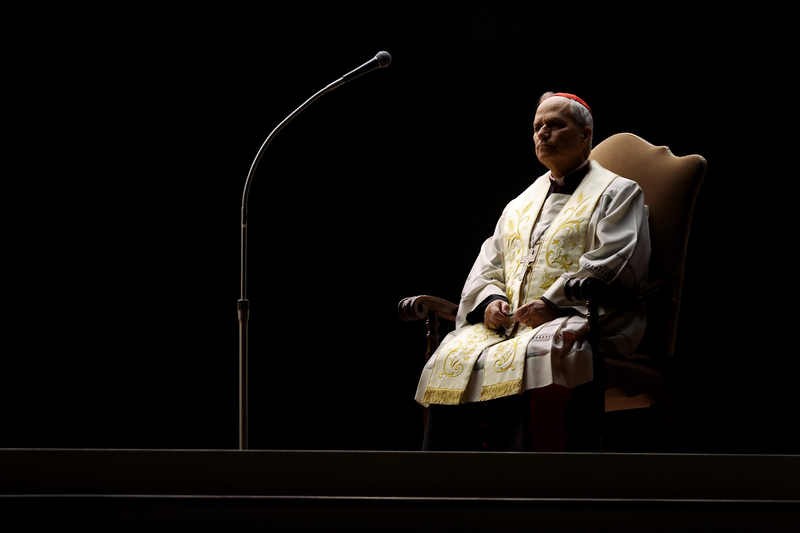 Then-‘Cardinal’ Robert F. Prevost prays the Rosary for Francis in St. Peter’s Square (Mar. 3, 2025)
Then-‘Cardinal’ Robert F. Prevost prays the Rosary for Francis in St. Peter’s Square (Mar. 3, 2025)Since his election as ‘Pope Leo XIV’, there has naturally been a flood of information published about Robert Francis Prevost, the new occupant of the Vatican’s Apostolic Palace. The man has a formidable resume as an Augustinian priest, later prior of the order, then bishop in Peru, and finally curial cardinal in the Vatican as head of the so-called Dicastery for Bishops — until the conclave chose him to be the head of the Vatican II Church (‘Pope’) on May 8, 2025.… READ MORE
-
Site: Novus Ordo Wire – Novus Ordo Watch
Allegations of cover-up and inaction… but are they true?
Leo XIV and the Sexual Abuse Crisis:
How Did Robert Prevost Deal With Misconduct Cases? Then-‘Cardinal’ Robert F. Prevost prays the Rosary for Francis in St. Peter’s Square (Mar. 3, 2025)
Then-‘Cardinal’ Robert F. Prevost prays the Rosary for Francis in St. Peter’s Square (Mar. 3, 2025)Since his election as ‘Pope Leo XIV’, there has naturally been a flood of information published about Robert Francis Prevost, the new occupant of the Vatican’s Apostolic Palace. The man has a formidable resume as an Augustinian priest, later prior of the order, then bishop in Peru, and finally curial cardinal in the Vatican as head of the so-called Dicastery for Bishops — until the conclave chose him to be the head of the Vatican II Church (‘Pope’) on May 8, 2025.… READ MORE
-
Site: Zero HedgeThe Justices Must At Long Last Deal With Chronic InjunctivitisTyler Durden Tue, 05/27/2025 - 14:25
This week, the Supreme Court continued to deliberate over what to do with the growing number of national or universal injunctions issued by federal district courts against the Trump Administration.
The court has long failed to address the problem, and what I have called “chronic injunctivitis” is now raging across the court system. Justices have only worsened the condition with conflicting and at times incomprehensible opinions.
Both Democratic and Republican presidents have long argued that federal judges are out of control in issuing national injunctions that freeze the entire executive branch for years on a given policy. For presidents, you have to effectively sweep the district courts 677-to-0 if you want to be able to carry out controversial measures. Any one judge can halt the entire government.
Under President Barack Obama, Justice Elena Kagan expressed outrage over the injunctions in public comments at Northwestern University School of Law. Kagan lashed out at the obvious “forum shopping” by then conservative advocates to get before favorable courts, insisting “It just cannot be right that one district judge can stop a nationwide policy in its tracks and leave it stopped for the years it takes to go through the normal [appellate] process.”
In his first term, Trump faced a more than 450 percent increase in the number of such injunctions over the number issued under Obama — a rise from 12 to 64. The number then went down to just 14 under former President Joe Biden. With Trump back in office, district courts have now outstripped that record and may surpass the total from the first term in the first year.
However, when the pending case came up before the Supreme Court on one of the Trump injunctions, Kagan suggested that this was “different,” because Trump was clearly wrong.
In oral argument, Kagan snapped at the Solicitor General: “Every court is ruling against you.”
It was a curious point coming from a justice who had previously acknowledged that challengers were forum-shopping by going to favorable judges, as with the current cases coming out of largely blue states.
Kagan did not explain where the line should be drawn, leading to speculation on when something would be viewed as “just sorta wrong” or “really, really wrong.”
This week, the Supreme Court enjoined the Maine House of Representatives from denying State Representative Laurel Libby her right to speak and vote on the floor. In an outrageous action, the Democratic majority had effectively taken Libby’s constituents hostage by telling her that, unless she apologized for identifying a transgender athlete in public comments, she could not vote. The Supreme Court voted 7-2 to lift the ban, with Kagan joining the more conservative justices.
However, in her dissent, Justice Ketanji Brown Jackson (who has favored the injunctions in the Trump cases) stressed that there was no need for an injunction here because there were no “significant legislative votes scheduled in the upcoming weeks” or where Libby’s lack of a vote would “impact the outcome.”
It again left many scratching their heads on what Jackson would consider a “significant vote.” Moreover, thousands of Maine residents have been denied representation on the state House floor. That would seem significant even if the justice did not find certain bills to be sufficiently weighty.
These different approaches only deepen the uncertainly over the standards for lower courts.
Just in case the Supreme Court doubted the need for greater clarity on the use of these injunctions, Boston District Judge Myong J. Joun, perfected the record this week.
The Biden appointee had just been reversed by the Supreme Court last month when he issued a temporary restraining order for the Trump Administration to pay out frozen grants worth more than $65 million. The administration had raised questions about the basis for the grants and ordered a review.
Usually, a temporary order freezes the parties from changing the status quo to allow for review.
It is difficult to appeal such an order, and the parties generally wait for a couple of weeks to seek review after the court issues a preliminary injunction.
But Judge Joun wanted to use the temporary restraining order to force the payments to happen, changing the status quo permanently.
This did not seem like temporary relief, since money is not likely to come back after it is paid out.
This week, Joun was back with another injunction. This time he enjoined an effort of Education Secretary Linda McMahon to initiate a reduction-in-force and prepare for the potential elimination of the Department of Education.
Despite the false claims that Trump’s underlying executive order actually shut down the department, it stated that McMahon should, “to the maximum extent appropriate and permitted by law, take all necessary steps to facilitate the closure of the Department of Education.”
While Joun admits that this was not a department shutdown, he still enjoined these efforts in an 88-page decision full of sweeping, dramatic language that sounds more like a policy paper than a restrained judicial order.
The court simply declared that even a reduction in force would make it “effectively impossible for the department to carry out its statutorily mandated functions.”
Many on the left again celebrated a judge effectively micromanaging the executive branch. Michael Mann, a climate professor and senior administrator at the University of Pennsylvania, even seemed to add a threat — that “If Trump doesn’t comply, we’re in second amendment territory.”
Insurrection aside, it is clearly time for the Supreme Court to do something about this.
Despite a majority of justices harrumphing for years about these injunctions, lower court judges continue to issue them with abandon. In the meantime, presidents like Trump are looking at two years of litigation before they can make meaningful changes, including downsizing the government.
For the Supreme Court, it has become madness as emergency motions pile up every morning after executive programs are frozen overnight.
The solution to chronic injunctivitis is simple: You give district judges a dose of clarity and tell them not to call you in the morning.
* * *
Jonathan Turley is the J.B. and Maurice C. Shapiro Professor of Public Interest Law at the George Washington University Law School, where he teaches a course on the Supreme Court and the Constitution.
-
Site: AsiaNews.itVatican Museums Director Barbara Jatta and Auxiliary Bishop Andrea Lembo of Tokyo explained the symbol of hope lent by the Vatican to the world expo currently underway in Japan. The painting is on display for six months in a dedicated area inside the Italian Pavilion. For the prelate, 'Caravaggio does not ask us to believe. He only asks us to look and try to recognise that that body could be ours'.
-
Site: Zero HedgeRussia Launches Large-Scale Naval War Drills In Baltic SeaTyler Durden Tue, 05/27/2025 - 14:05
Russia has initiated large-scale naval exercises in the Baltic Sea, which feature at least 20 warships and 3,000 troops along with air support, the Baltic Fleet of Russia confirms as cited in Interfax.
"As part of the exercise, the crews of the fleet's ships will solve anti-submarine tasks in combat training areas, practice defense against unmanned boats, and conduct practical artillery fire at sea and air targets," a Russian military statement indicates. This appears to be a mirroring response to provocative NATO drills currently happening in Finland, near the Russian border.
 Prior exercises in Baltic Sea, Anadolu Agency
Prior exercises in Baltic Sea, Anadolu Agency
This drills further include frigates, corvettes, small missile and anti-submarine ships, as well as minesweepers, regional media details. There's also air coverage, with up to 25 aircraft and helicopters taking part.
"Currently, the ships have left their bases and deployed to designated areas of the Baltic Sea to perform combat training missions," the Russian Baltic Fleet further says.
The Baltic Sea has remained a regional maritime flashpoint due to the still raging war in Ukraine, and the past year has seen Baltic Sea countries affected by the destruction of undersea telecom cables, which were promptly blamed on Russia, but in some instances have been declared accidents. Also, a Chinese vessel in at least one case was also accused.
Tensions in the Baltic Sea also grew hotter after Scandinavian countries Finland and Sweden abandoned their historic neutrality and became the newest NATO members.
The potential for more undersea cable-cutting incidents remains amid heightened concerns of potential sabotage by agents of China and or Russia, raising alarms about hybrid warfare tactics targeting Western telecommunication infrastructure worldwide.
NATO has also held drills in both regional waters and along Russia's border with Scandinavia of late. Finland only entered the North Atlantic alliance in April 2023.
Significantly, the country shares a 1,340-kilometre (830 mi) border with Russia, and Moscow has previously warned that this could result of the greater militarization of the Baltic region. President Putin in 2023 had brushed off Finland and Sweden entering NATO as but a "meaningless" move which will in the end only harm their own national interests.
Both had previously economically benefited from their positive relations with Russia, but now border closures and worsening relations have been the trend.
 TASS images featuring start of new drills.
TASS images featuring start of new drills.
It goes without saying that tit-for-tat mirroring drills in these Baltic and northern European regions do little to foster Ukraine peace talks and dialogue. The warring sides are currently feeling the pressure from the Trump administration to continue 'direct' negotiations in the wake of the last Istanbul meeting.
-
Site: LifeNews
The Charlotte Lozier Institute (CLI) released a new pivotal peer-reviewed article published in the journal BioTech. This article challenges and disproves the baseless claim that “abortion drugs are safer than Tylenol” because it lacks scientific credibility and evidence. It examines the prolific claim that has been a heavily relied upon talking point for the abortion lobby.
The new research exposes the claim’s origins and highlights the abortion lobby’s ignorance of the FDA’s established drug safety communication standards. Comparisons between the two drugs combine unrelated data, ignoring their distinct purposes, risks and contexts. This oversimplification led to the creation of a catchy phrase aimed at reducing abortion drug regulations and minimizing concerns from women considering an abortion.
Follow LifeNews.com on Instagram for pro-life pictures and videos.
Key Findings:
- Flawed methodology: To validate the claim, there must be a controlled, scientifically appropriate study comparing abortion drugs to Tylenol. No such study exists, and it would be impossible to do so because these drugs are used for entirely different purposes.
- Overlooked risks: The FDA assesses drug safety based on a range of factors, not just death rates. The comparison ignores serious adverse events of abortion drugs, such as sepsis and hemorrhage.
- Context misrepresentation: While Tylenol-related deaths often result from misuse in a much larger user base, deaths from abortion drugs occur under prescribed use.
Cameron Louttit, Ph.D., director of life sciences at CLI and author of the article, said:
“For years now, the abortion lobby’s claim that abortion drugs are ‘safer than Tylenol’ has dominated public discussion, propelled by the illusion of scientific consensus. However, no such support exists. This baseless claim, repeated by medical societies, politicians, media pundits and researchers, has profoundly influenced public opinion and policy. But as this paper details, those spreading it lack the evidence they routinely claim.”
To learn more, read the peer-reviewed article in its entirety HERE.

The post Peer-Reviewed Study Debunks Claim That Abortion Drugs Are Safer Than Tylenol appeared first on LifeNews.com.
-
Site: Catholic ConclaveDiocesan Committee Criticizes Awarding of Josef Pieper Prize to US Bishop BarronFrom the website of the Josef Pieper Foundation"The Josef Pieper Prize is awarded every five years for exemplary publications and works on the Christian view of humanity that meet academic standards and deserve broad interest due to their linguistic design."Pieper was a fabulous author and Thomist who regretted his Catholic Conclavehttp://www.blogger.com/profile/06227218883606585321noreply@blogger.com0
-
Site: Zero HedgeIntel Officials Warned COVID-19 Vaccine Mandates Could Spur Violence: Declassified ReportTyler Durden Tue, 05/27/2025 - 13:45
Authored by Zachary Stieber via The Epoch Times,
A U.S. intelligence document declassified on May 23 shows the government warned that COVID-19 vaccine mandates could lead to violence.
The FBI, Department of Homeland Security, and National Counterterrorism Center said in the Dec. 31, 2021, joint assessment that vaccine mandates for children and workers—which had begun being imposed by the federal government—as well as “perceptions of unfair healthcare treatment for the unvaccinated” could trigger violence from domestic violent extremists (DVEs) or foreign actors.
“Given these conditions, DVEs would most likely plot violent acts to intimidate healthcare workers and officials charged with implementing COVID-19 mitigation measures as well as, possibly, killings or kidnappings of state, local, or federal government personnel,” the officials stated.
Plotting had already occurred in the United States and other countries, according to the intelligence agencies. That included a plot to kidnap Michigan Gov. Gretchen Whitmer, although some of the men charged in that matter were acquitted after they argued they were entrapped by government agents.
The joint assessment also said that COVID-19 vaccines becoming available for children “might spur conspiracy theories and perceptions that schools will vaccinate children against parents’ will and may increase the potential for violence.”
Some health care workers did vaccinate children despite opposition from parents, including in North Carolina.
U.S. intelligence agencies define a domestic violent extremist as a person based in the United States or U.S. territories who acts without direction or inspiration from a foreign terrorist group or country and who “seeks to further political or social goals, wholly or in part, through unlawful acts of force or violence dangerous to human life.”
The assessment stated in a footnote that U.S. individuals opposing COVID-19 mandates were “likely engaging in First Amendment-protected activities, unless they are acting in concert with a threat actor,” and that related topics “should not be assumed to reflect DVE activity, absent information specifically attributing the content to DVE threat actors.”
Director of National Intelligence Tulsi Gabbard ordered the declassification of the document.
“It really talks about people who may likely turn out to be domestic violent extremists or those who may turn to violence because of these specific ‘ideologies’ that they hold,“ Gabbard said about the document during an appearance on Fox News.
”And there’s a consistent thread through here that these ideologies that they are characterizing as potentially turning into potentially violent activities happen to be people who were using their First Amendment rights to oppose certain policies of the Biden Administration.”
She added, “Some of the examples that are focused on there have to do with those who oppose the COVID vaccine mandates, those who oppose the mask mandates, parents who were concerned that their children going to school may be forcibly vaccinated with the COVID vaccine without the consent or awareness of parents.”
The FBI and Department of Homeland Security did not respond to requests for comment.
-
Site: PeakProsperityAll the news that tried to escape! We're not in Kansas anymore, Dorothy.
-
Site: Zero Hedge"Just Gone. Like It Never Existed": YouTube Nukes Top Canadian Political Account After State-Funded Media ComplainsTyler Durden Tue, 05/27/2025 - 13:35
A Canadian YouTube channel that was dominating the platform during the country's recent election has vanished, after the state-funded Canadian Broadcasting Corporation reached out to the social media giant, and branded it a 'content farm' in a Friday hit-piece.
The channel, "Real Talk Politiks," had over 300,000 subscribers and more than 70 million views in the month of April, according to ViewStats.com - making it the third-most viewed Canadian news and politics channel over the past three months.
In a Sunday thread on X, Real Talk Politiks explained:
CBC, Canada’s state-funded media just got YouTube to terminate my channel — not for breaking rules, but for having the wrong political views.
CBC couldn’t compete with the content… so they tried to erase it. This is censorship in Canada.
I didn’t break any rules. No strikes. No deception. Just political commentary. And yet — YouTube terminated the entire channel shortly after CBC reached out with hit-piece questions.
Here’s what’s wild: I was pulling more views than CBC, which really bothered them. They clearly don’t understand how YouTube works with most of the audience outside Canada. But CBC — desperate for relevance — couldn’t stand that.
So what did they do? They contacted YouTube. And not long after… the channel vanished. No real explanation. No public process. Just gone. Like it never existed.
CBC and YouTube clearly don’t understand how the internet works. They think they can silence people with opposing views. But all they’ve done is expose their own fear — and their willingness to crush speech they don’t like.
When state media and Big Tech team up to silence a creator because of political ideology, it’s not just censorship — it’s tyranny with a smile.
Apparently CBC pointed to an AI video of Ronald Reagan that was not properly labeled as such, prompting YouTube to justify the takedown for violations of its policies on "spam, deceptive practices and scams," which - they could have simply issued a warning for and allowed Real Talk Politiks to correct instead of completely disappearing the account.
The CBC cited University of Ottawa associate professor Elizabeth Dubois...
...who said "These types of accounts are presenting themselves as the way to get informed and they are embedding partisan perspectives typically within that information delivery," adding "So it's really causing this shift in what information people are receiving, and it's also going to force us to really reconsider what we think of as media literacy."
Heaven forbid people consume whatever media they want and form their own opinions.
The CBC is openly bragging about it - uploading a video to YouTube (comments off, of course), titled "How we shut down one of Canada's biggest news 'content farms'"
Openly bragging about getting the channel shut down too. https://t.co/SMwuiWnayT pic.twitter.com/U8jCL0k1fQ
— L (@SomeBitchIIKnow) May 27, 2025I’m actually shocked.
— Mario Zelaya (@mario4thenorth) May 27, 2025
CBC is straight up bragging: “How we shut down one of Canada’s biggest news content farms”
This is literally the description on their YouTube channel and it shows that they get more views than them and CTV news.
Unbelievable. pic.twitter.com/8rDSshIZQgInsane!
-
Site: Zero HedgeYields Near Session Lows After Strong 2Y Treasury Auction Stops ThroughTyler Durden Tue, 05/27/2025 - 13:29
After several weeks of very ugly bond action, overnight Japan finally panicked and in a coordinated trial balloon through both Reuters and Bloomberg, the MOF announced that it would trim ultra long-dated supply, reduciing the amount of 30Y and 40Y bonds Japan would sell... and not a moment to soon since yields had hit record highs in what was a bidless market, sparking record paper losses among life insurers.
In the aftermath of the announcement, yields both in Japan and across the globe have tumbled, and that certainly helped today's US Treasury auction of $69BN in 2Y paper pass smoothly.
At exactly 1:01pm, the US Treasury announced it completed the week's first coupon auction when it sold $69BN in 2 Year notes at a high yield of 3.955%, up from last month's 3.795% if below the march 3.984% and the five consecutive prior auctions all of which priced above 4%. The auction also stopped through the 3.965% When Issued by 1bps, the 3rd stopping through auction in the past four.
The bid to cover was 2.567 slightly higher than last month's 2.515 if below the six auction average of 2.648.
The internals were also solid, with Indirects awarded 63.3%, up from 56.2% in the ugly April 2Y auction; and with Directs taking 26.2%, the second highest this decade, Dealers were left holding 10.5%, down from 13.7% in April and just below the 10.9% six-auction average.
Overall, this was a very solid auction yet one which undoubtedly good a boost from Japan's panicking Ministry of Finance whose "bond put" has been triggered and from now on, the choice of whether to short JGBs or yen will almost surely point toward the latter. And, sure enough, after trading around 4.65% just two trading days ago, the yield on benchmark US paper was near session lows ahead of the auction and at 4.45% at last check, some 20 bps lower in two days.
-
Site: Henrymakow.com
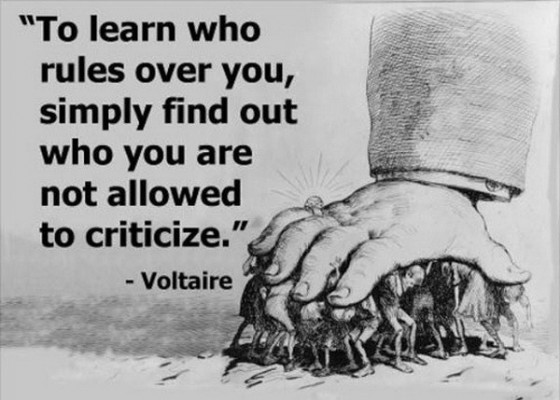 Please send links and comments to hmakow@gmail.com
Please send links and comments to hmakow@gmail.com
Rick Wiles says, An easy way to know you are controlled is who can't you criticize??It doesn't even occur to Rick Wiles to mention Freemasonry which is the rubricused by Organized Jewry (Rothschilds) to recruit traitors (i.e. our "leaders.")We are experiencing a social breakdown partly because we don't have the cajonesor brains to analyze the problem properly. It's not just "the Jews."Wiles--"In Nazi Germany. USSR. N Korea you couldn't criticize Nazis or Communists. In America, who can't you criticize??The power of the Israeli lobby AIPAC which Wiles called the "third rail of US politics" "They control America. They control free speech."-New Penn State poll confirms Jewish Israeli Society is Completely Unredeemable, and a Dire Threat to Humanity-82% support the forced expulsion of residents of Gaza-56% support the forced expulsion of Arab citizens of Israel -47% believe the Israeli army should "act like the biblical Israelites under Joshua in Jericho--killing all inhabitants of a conquered city"-65% "believe in a modern-day incarnation of Amalek, a biblical enemy of the Jews"-93% of those who believe in "Amalek" believe the biblical command to "erase Amalek" still applies today-69% of secular Israelis support expelling Gaza's population,-and 31% support mimicking the biblical destruction of Jericho -Just 9% of men under 40 oppose all genocide scenarios for Palestinians---Michael Hoffman does not understand that Hitler was a British Agent
-47% believe the Israeli army should "act like the biblical Israelites under Joshua in Jericho--killing all inhabitants of a conquered city"-65% "believe in a modern-day incarnation of Amalek, a biblical enemy of the Jews"-93% of those who believe in "Amalek" believe the biblical command to "erase Amalek" still applies today-69% of secular Israelis support expelling Gaza's population,-and 31% support mimicking the biblical destruction of Jericho -Just 9% of men under 40 oppose all genocide scenarios for Palestinians---Michael Hoffman does not understand that Hitler was a British Agent"The Plain Truth: Everyone in Germany was Hitler's Slave
It is at this juncture where a plain fact which many of Hitler's admirers flee, must be faced: everyone in Germany was Hitler's slave. With his ascent to power in 1933 the rule of law in the ancient Teutonic nation--cradle of art, music, literature, philosophy, science and technology--had been crushed, in what was a revival of primitive, absolute rule by one man."
The "plain truth" is that Hitler was immensely popular in Germany and that Nazism, although a trap, represented a national renaissance.---TORONTO Bans Protests Outside Synagogues"Toronto did it. It passed a non-sensical bylaw because Zionists want to be comfortable when they shill for genocide. That's what bubble legislation is first and foremost. People were protesting outside of synagogues because there were settlement properties, stolen Palestinian land, being sold inside them. This is what the councillors never talked about in the council chambers. The root causes.Anyway, this ridiculous legislation will have zero effect. All it does is cost tax payers 2 million dollars and clog up our courts. Keep in mind that according to the public consultation 77 percent of Toronto did not want this bylaw.- Viewer--This is not just the fall of Minneapolis; this is the beginning of the fall of America. Films like this can bring a change. I want to thank the author, producer, and the whole team for the truth. Truth is the biggest deficit of our time.Minneapolis resident--"When the George Floyd event took place, we were wrestling with the COVID pandemic and life was disrupted everywhere. People were on edge just because of the threat of the pandemic with the wearing of masks, public building closings and fear of actually getting sick. A spark was all it took to ignite the whole city on fire. George Floyd was that spark and Minneapolis burned.We would watch the riots on the local news. It was so outrageous at the time, one wondered if it was made up or exaggerated. It was reported that men would use crow bars and just knock out windows of store fronts in Minneapolis. There was looting as well. (A bad joke was that work boots and work gloves were never looted from stores.) I felt a betrayal by our elected officials when the 3rd Street Police Precinct was burned. If they cannot protect their police stations, what can they protect? I realized then that this burning was done for political gain. Law and order were sacrificed for the Democratic Party's gain. Then again, I don't even remember any Republican response.There was a lot of disinformation circulating at the time. One of the more curiouser stories was that the George Floyd was actually a respiration training dummy when he was on the ground. They even showed pictures of the look-alike dummy used in classes for respiratory training. Another story was he and Chauvin knew each other from working at a night club a few years ago. After a while, one didn't know what to believe. Even the trial was suspicious because it did leak out that not all information was being reviewed by the court. One could wonder if the whole thing was a political put on without the majority of participants having a clue of it being so.It served the Democrats well with the memorials, the funeral, the tearing down of Christopher Columbus statue at the State Capitol and so on. It was a time of a breakdown of law and order. The video clearly shows that the entire matter should be reviewed again."-
Viewer--This is not just the fall of Minneapolis; this is the beginning of the fall of America. Films like this can bring a change. I want to thank the author, producer, and the whole team for the truth. Truth is the biggest deficit of our time.Minneapolis resident--"When the George Floyd event took place, we were wrestling with the COVID pandemic and life was disrupted everywhere. People were on edge just because of the threat of the pandemic with the wearing of masks, public building closings and fear of actually getting sick. A spark was all it took to ignite the whole city on fire. George Floyd was that spark and Minneapolis burned.We would watch the riots on the local news. It was so outrageous at the time, one wondered if it was made up or exaggerated. It was reported that men would use crow bars and just knock out windows of store fronts in Minneapolis. There was looting as well. (A bad joke was that work boots and work gloves were never looted from stores.) I felt a betrayal by our elected officials when the 3rd Street Police Precinct was burned. If they cannot protect their police stations, what can they protect? I realized then that this burning was done for political gain. Law and order were sacrificed for the Democratic Party's gain. Then again, I don't even remember any Republican response.There was a lot of disinformation circulating at the time. One of the more curiouser stories was that the George Floyd was actually a respiration training dummy when he was on the ground. They even showed pictures of the look-alike dummy used in classes for respiratory training. Another story was he and Chauvin knew each other from working at a night club a few years ago. After a while, one didn't know what to believe. Even the trial was suspicious because it did leak out that not all information was being reviewed by the court. One could wonder if the whole thing was a political put on without the majority of participants having a clue of it being so.It served the Democrats well with the memorials, the funeral, the tearing down of Christopher Columbus statue at the State Capitol and so on. It was a time of a breakdown of law and order. The video clearly shows that the entire matter should be reviewed again."- The Muslim Brotherhood are FreemasonsFrance Has Fallen to the Muslim Brotherhood: A Government Report Exposes the Islamic Network Within"A landmark French intelligence report has revealed that the Muslim Brotherhood has constructed a vast, foreign-funded, ideologically driven infrastructure across France - spanning mosques, schools, digital media, and parallel local governance systems - with the ultimate goal of replacing secular democratic rule with Sharia, and warns that this same model is being replicated in Western nations, including the United States."The Muslim Brotherhood in France operates through a dual system: a legal, publicly visible structure of associations and mosques, and a clandestine ideological command guided by a "Council of Judges." This duality allows the Brotherhood to avoid scrutiny while executing long-term strategies for societal transformation. The core leadership comprises an estimated 400 to 1,000 committed members who direct over 280 affiliated associations and 139 mosques across France.-
The Muslim Brotherhood are FreemasonsFrance Has Fallen to the Muslim Brotherhood: A Government Report Exposes the Islamic Network Within"A landmark French intelligence report has revealed that the Muslim Brotherhood has constructed a vast, foreign-funded, ideologically driven infrastructure across France - spanning mosques, schools, digital media, and parallel local governance systems - with the ultimate goal of replacing secular democratic rule with Sharia, and warns that this same model is being replicated in Western nations, including the United States."The Muslim Brotherhood in France operates through a dual system: a legal, publicly visible structure of associations and mosques, and a clandestine ideological command guided by a "Council of Judges." This duality allows the Brotherhood to avoid scrutiny while executing long-term strategies for societal transformation. The core leadership comprises an estimated 400 to 1,000 committed members who direct over 280 affiliated associations and 139 mosques across France.- Canadian heroes, Tamara Lich and Chris BarberFreedom Convoy Leader Still Fighting in Court, says 'This is Not Canada'Viewer--"Every person in Canada should help this man, if we allow this to happen our rights to protest ( unless you are from or for Palestine ) are gone. I urge everyone with a sense of Justice write or call your MP."-EYRE: The 'Propaganda Module' that's taken hold at the University of SaskatchewanThat's how such programs fester. They're planned in stealth, delivered by mandatory enforcement, and pitched as "free and open discourse"--when they're anything but.-Fully Vaccinated Billy Joel Diagnosed With 'Sudden Onset' Brain Disorder"...the brain disorder is a known side-effect of COVID mRNA vaccines, and Joel was a prominent supporter of the experimental vaccine roll out."-
Canadian heroes, Tamara Lich and Chris BarberFreedom Convoy Leader Still Fighting in Court, says 'This is Not Canada'Viewer--"Every person in Canada should help this man, if we allow this to happen our rights to protest ( unless you are from or for Palestine ) are gone. I urge everyone with a sense of Justice write or call your MP."-EYRE: The 'Propaganda Module' that's taken hold at the University of SaskatchewanThat's how such programs fester. They're planned in stealth, delivered by mandatory enforcement, and pitched as "free and open discourse"--when they're anything but.-Fully Vaccinated Billy Joel Diagnosed With 'Sudden Onset' Brain Disorder"...the brain disorder is a known side-effect of COVID mRNA vaccines, and Joel was a prominent supporter of the experimental vaccine roll out."- We are controlled by Christian Zionist MoronsWhy was the Secretary of Homeland Security in Israel? Someone should inform Kristi Noem that 'homeland' in her job title means the United States, not Israel. Doesn't she have more pressing matters to attend to at home?-Iranian President Pezeshkian And Iranian Regime Mouthpiece 'Kayhan' Threaten Closure Of Strait Of Hormuz; Senior Regime Official Ali Larijani, Associate Of Iranian Supreme Leader Khamenei, Threatens Attacks On Washington, D.C. And On American Interests In The RegionIn light of the significant gaps emerging in the U.S.-Iran nuclear negotiations - Iran insists on the right to enrich uranium on its territory however it wishes, while the U.S. wants to prohibit it from doing so in any way, shape, or form - senior Iranian officials are threatening the U.S. and Western interests.In a speech at the Tehran Dialogue Forum on May 18, 2025, Iranian President Masoud Pezeshkian threatened to block the passage of oil from the Persian Gulf to the West, in response to the U.S., which, he said, seeks to steal other countries' resources and to foment conflict among the Islamic nations.Mohammad Javad Larijani, Former Iranian Judiciary Human Rights Council Secretary, May 19, 2025: "If We Are Attacked, We Will Attack Not Only Washington, But American Interests And Bases Everywhere - In The Air, On The Sea, And On Land, Anywhere From Which An Attack On Iran Originates - Will Be A Legitimate Target For Us"-Zionist psychos are blackmailing humanity
We are controlled by Christian Zionist MoronsWhy was the Secretary of Homeland Security in Israel? Someone should inform Kristi Noem that 'homeland' in her job title means the United States, not Israel. Doesn't she have more pressing matters to attend to at home?-Iranian President Pezeshkian And Iranian Regime Mouthpiece 'Kayhan' Threaten Closure Of Strait Of Hormuz; Senior Regime Official Ali Larijani, Associate Of Iranian Supreme Leader Khamenei, Threatens Attacks On Washington, D.C. And On American Interests In The RegionIn light of the significant gaps emerging in the U.S.-Iran nuclear negotiations - Iran insists on the right to enrich uranium on its territory however it wishes, while the U.S. wants to prohibit it from doing so in any way, shape, or form - senior Iranian officials are threatening the U.S. and Western interests.In a speech at the Tehran Dialogue Forum on May 18, 2025, Iranian President Masoud Pezeshkian threatened to block the passage of oil from the Persian Gulf to the West, in response to the U.S., which, he said, seeks to steal other countries' resources and to foment conflict among the Islamic nations.Mohammad Javad Larijani, Former Iranian Judiciary Human Rights Council Secretary, May 19, 2025: "If We Are Attacked, We Will Attack Not Only Washington, But American Interests And Bases Everywhere - In The Air, On The Sea, And On Land, Anywhere From Which An Attack On Iran Originates - Will Be A Legitimate Target For Us"-Zionist psychos are blackmailing humanity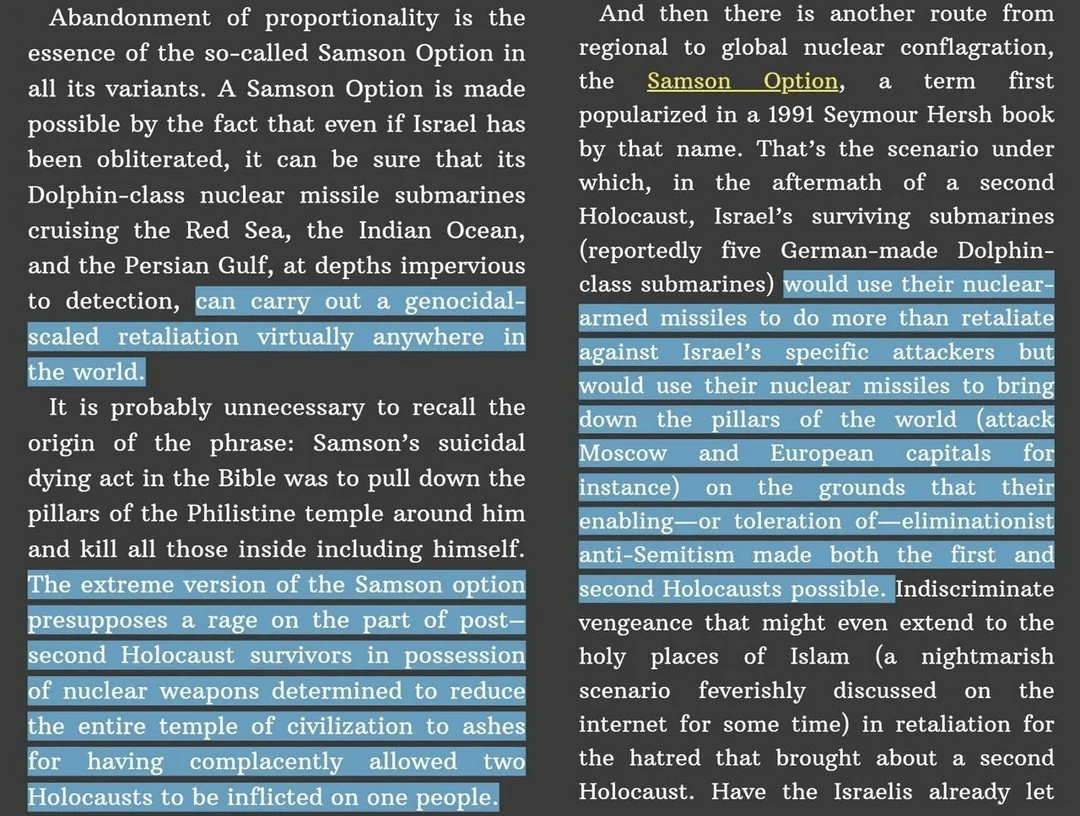 -Gabbard Declassifies Docs Showing Biden Classified Opponents of COVID Mandates "Domestic Violent Extremists"-A massive new preprint study of over a million Czech women aged 18-39 claims women vaccinated for COVID-19 had 33% fewer successful pregnancies than unvaccinated women. If the study is correct, the vaccines are having a catastrophic effect on fertility.-"israel is a dictatorship de facto" sign raised in a protest in tel aviv demanding an end to the war in gazaIsraeli protesters demand end to Gaza warDemonstrators gathered in Tel Aviv urging the Israeli government to stop the fighting in Gaza. Some called for a ceasefire deal that could secure the return of hostages, while others want to see Israeli Prime Minister Benjamin Netanyahu resign.-
-Gabbard Declassifies Docs Showing Biden Classified Opponents of COVID Mandates "Domestic Violent Extremists"-A massive new preprint study of over a million Czech women aged 18-39 claims women vaccinated for COVID-19 had 33% fewer successful pregnancies than unvaccinated women. If the study is correct, the vaccines are having a catastrophic effect on fertility.-"israel is a dictatorship de facto" sign raised in a protest in tel aviv demanding an end to the war in gazaIsraeli protesters demand end to Gaza warDemonstrators gathered in Tel Aviv urging the Israeli government to stop the fighting in Gaza. Some called for a ceasefire deal that could secure the return of hostages, while others want to see Israeli Prime Minister Benjamin Netanyahu resign.- The Democrat Mayor of Seattle, Bruce Harrell, issued a statement regarding the concert and arrests where he labeled the event a "far-right rally."Harrell also accused the Christian group of trying "to provoke a reaction by promoting beliefs that are inherently opposed to our city's values, in the heart of Seattle's most prominent LGBTQ+ neighborhood."The mayor then ordered the city's parks department to explain why a permit was granted for the concert and launched an investigation into the response of the police department."I am grateful for those who make their voices heard in support of our neighbors without resorting to violence. In the face of an extreme right-wing national effort to attack our trans and LGBTQ+ communities, Seattle will continue to stand unwavering in our embrace of diversity, love for our neighbors, and commitment to justice and fairness," Mayor Harrell wrote.
The Democrat Mayor of Seattle, Bruce Harrell, issued a statement regarding the concert and arrests where he labeled the event a "far-right rally."Harrell also accused the Christian group of trying "to provoke a reaction by promoting beliefs that are inherently opposed to our city's values, in the heart of Seattle's most prominent LGBTQ+ neighborhood."The mayor then ordered the city's parks department to explain why a permit was granted for the concert and launched an investigation into the response of the police department."I am grateful for those who make their voices heard in support of our neighbors without resorting to violence. In the face of an extreme right-wing national effort to attack our trans and LGBTQ+ communities, Seattle will continue to stand unwavering in our embrace of diversity, love for our neighbors, and commitment to justice and fairness," Mayor Harrell wrote. -
Site: Saint Louis Catholic
 Screenshot
Screenshot
The poll on the Traditional Latin Mass has been up for a week and the results are in. Not a ton of optimism out in TradLand about Pope Leo XIV’s election in terms of a freeing of the TLM, and of the optimists, most think the current unjust putative legal framework will remain, but that more “indults” (I use the term intentionally) will be granted when asked for.
Only about 29% think any positive decree or legislation will be forthcoming. And the number who see an abrogation of TC and/or restoration of Summorum Pontificum hovers at 20%.
Nearly half (47%) think it will remain the same or, worse, that the TLM will be subject to further putative restrictions or suppression.
I leave this whole effort here for the historical record. Let’s pray that the minority is right.
-
Site: Mises InstituteFrom Reconstruction to George Floyd, the left‘s guilt industry has run at full speed. As Murray Rothbard wrote, it is time to stand up to those that use guilt as a social weapon.
-
Site: Mises InstituteFrom Reconstruction to George Floyd, the left‘s guilt industry has run at full speed. As Murray Rothbard wrote, it is time to stand up to those that use guilt as a social weapon.
-
Site: Rorate CaeliDear faithful,It has unfortunately come to my attention over the years that an unscrupulous individual “ambulance chaser” type with a canon law degree has been approaching unsuspecting traditional Catholics with promises of aiding in canonical redress with their bishops after their local TLM has been canceled.It has fallen to me, in the absence of any interest in covering this issue by reputable Father Kevin M Cusick http://www.blogger.com/profile/04460394747724581336noreply@blogger.com
-
Site: Zero HedgeTrump Admin Pauses All Student Visa Interviews, May Include Social Media Vetting: ReportTyler Durden Tue, 05/27/2025 - 12:25
The Trump administration has paused all new interviews for foreign student visa applicants, and is may institute social media vetting, according to a cable obtained by Politico.
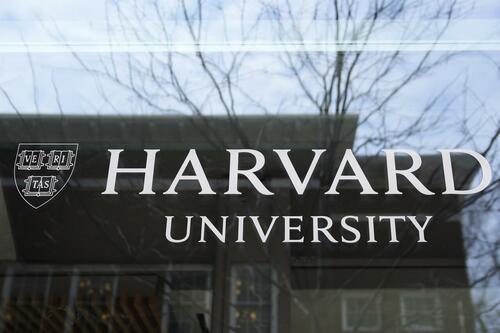 The Harvard University logo is displayed on a building at the school, April 15, 2025, in Cambridge, Massachusetts. | Charles Krupa/AP
The Harvard University logo is displayed on a building at the school, April 15, 2025, in Cambridge, Massachusetts. | Charles Krupa/AP
In the Tuesday cable signed by Secretary of State Marco Rubio, the administration has ordered US embassies and consular sections to pause scheduling new interviews - a move that could severely slow down student visa processing, and hurt many universities such as Harvard which rely heavily on foreign students.
"Effective immediately, in preparation for an expansion of required social media screening and vetting, consular sections should not add any additional student or exchange visitor (F, M, and J) visa appointment capacity until further guidance is issued septel, which we anticipate in the coming days," reads the cable. ("Septel" is short for "separate telegram.")
According to the report, the administration has already imposed some social media screening requirements largely aimed at returning students who may have participated in protests against Israel's actions in Gaza.
The administration has been trying to crack down on universities, especially elite ones such as Harvard, that it sees as too liberal and accuses of allowing antisemitism to flourish on their campuses. At the same time, it is carrying out immigration crackdowns that have swept up a number of students as well. -Politico
Earlier Tuesday, the NY Times reported that the Trump administration is set to cancel the federal government's remaining federal contracts with Harvard University - worth some $100 million.
In a letter to the university, the administration instructs agencies to "find alternative vendors" for future services.
Contracts with about nine agencies would be affected, according to the administration official.
Examples of contracts that would be affected, according to a federal database, include a $49,858 National Institutes of Health contract to investigate the effects of coffee drinking and a $25,800 Homeland Security Department contract for senior executive training. Some of the Harvard contracts under review may have already been subject to “stop work” orders. -NY Times
"Going forward, we also encourage your agency to seek alternative vendors for future services where you had previously considered Harvard," the letter states.
The latest cuts represent what one administration official told the outlet amounted to a 'complete severance' of the government's longstanding business relationship with Harvard.
The Trump administration has demanded that universities reject students who are "hostile to American values."
Harvard, meanwhile, has filed a lawsuit seeking the restoration of more than $3 billion in federal funding. In a separate lawsuit, the university has asked a federal court to reinstate its right to enroll international students - which Judge Allison D. Burroughs temporarily reinstated. A hearing on Thursday has been scheduled to determine whether the order should be extended.
-
Site: Mises InstituteState-funded media has been a hallmark of the Soviet Union and of all other oppressive, totalitarian regimes in history.
-
Site: Mundabor's blogYou might say that it is not good for me to keep harping on how bad Francis was. De mortuis nihil nisi bonum, parce sepultis, and all that stuff. However, I have often expressed the opinion that such charitable attitude should be reserved to those who are not public figures, lest their evil acts have […]
-
Site: Rorate CaeliThis was sent to us yesterday, and also first posted online by Fr. John Zuhlsdorf: the talking points shared by the Bishop of Charlotte, Bp. Martin, to explain to the faithful his monstrous anti-traditional actions.They are so grotesque, and so absurd for any bishop, that it pains us to believe they are real -- but they indeed are. So we leave them here for the record of current events, New Catholichttp://www.blogger.com/profile/04118576661605931910noreply@blogger.com
-
Site: AsiaNews.itAt least four waves of arrests have decimated the leadership of the Istanbul municipality. In addition to the mayor and opposition leader, more than 200 people are in jail. The CHP accuses the government of weaponising the judiciary. In the background, the president's overtures to the PKK are an attempt to win over the Kurds in his plan to change the constitution.
-
Site: Zero HedgeJapan Panicks As Yields Explode, Will Trim Super-Long Bond Issuance To Calm MarketTyler Durden Tue, 05/27/2025 - 11:25
One of the most famous modern aphorisms on Wall Street belongs to Bank of America Chief Investment Strategist, Michael Hartnett, who a decade ago wisely said that "markets stop panicking when policymakers start panicking." Last night, Japan's policymakers - faced with record long-end rates and record paper losses on insurer books - finally panicked.
Just hours after we reported that Japan's life insurance companies are facing staggering losses...
... first Reuters and then Bloomberg reported (which means that this was not a "scoop" but a premeditated trial balloon by Tokyo meant to hit all major news outlets) that Japan will take a page right out of Janet Yellens' Activist Treasury Issuance playbook and will "consider" trimming issuance of super-long bonds in the wake of recent sharp rises in yields for the notes, in an attempt to remove long-dated supply which has slammed prices for long-dated bonds to record low as policymakers seek to soothe market concerns about worsening government finances.
Predictably, super-long bond yields slumped on the report, pushing down the Japanese yen and U.S. Treasury yields along the way, as markets cheered Tokyo's readiness to arrest spikes in long-term interest rates by shifting duration from the long-end to the short-end.
According to Reuters, Japan's Ministry of Finance (MOF) will consider tweaking the composition of its bond program for the current fiscal year, which could involve cuts to its super-long bond issuance, said the sources who had direct knowledge of the plan. This is very similar to the ATI Yellen unveiled a little over two years ago when she shifted much of the bond issuance from coupons to bill, in order to keep funding the US deficit through Bills, and the draining of the Reverse Repo account, which is now almost empty.
The MOF will make a final decision after discussions with market participants around mid- to late-June, the sources said.
The plan followed the recent record surge in super-long bond yields to never before seen levels due to a freeze in demand from traditional buyers such as life insurers and global market jitters over steadily rising debt levels.
The yield on the 30-year Japanese government bond (JGB) fell 18 basis points to 2.85% after the report, its lowest since May 4. The benchmark 10-year yield dropped 7 points to 1.43%.
The slide in super-long JGB yields also helped push long-dated US Treasury yields, which were set for their biggest one-day fall since mid-April. The yield on 30-year bonds was down 7 basis points at 4.963% in early London trading on Tuesday.
"We've been arguing that something had to give to correct the supply-demand imbalance in long-end JGBs. The market is thinking it will be the MOF," Societe Generale said in a note, echoing what we in turn have been saying for weeks.
If the MOF were to reduce issuance of 20-, 30- or 40-year JGBs, it would likely increase issuance of shorter-dated debt instead, the sources said; As such, the total planned size of JGB issuance for the current fiscal year that ends March 2026 will remain unchanged from 172.3 trillion yen ($1.21 trillion), they said.
Such a move would also mean that any marginal demand for duration would have to head to the US, which thanks to the Trump Big, Beautiful, Budget Busting Deal will have lots of long-dated supply for years to come.
Global markets have been rattled by sharp bond sell-offs recently, including for US Treasuries, as President Trump's sweeping tariffs and erratic policies heightened worries about the status of U.S. sovereign debt as the world's safest haven. In Japan, super-long bonds were also sold off as Prime Minister Shigeru Ishiba faced political pressure for tax cuts and big spending ahead of an upper house poll in July, policies that could add to the country's already huge public debt.
Japan's government is considering compiling another spending package, though ruling coalition executives agreed on Tuesday to avoid issuing fresh deficit-financing bonds. The clash over fiscal policy prompted Japan's PM to say the quiet part out loud, admitting last week that Japan's financial condition was worse than Greece.
The JGB collapse has also turned investors' attention to whether the MOF, which oversees debt issuance, and BOJ could take measures to tame rises in super-long yields.
The BOJ, for its part, is unlikely to make any big tweaks to its current bond-taper (or QE) program, sources told Reuters. But the recent market rout could affect its taper plans for fiscal 2026 onward, which will be decided at next month's policy meeting, they said.
"Issuance of super-long JGBs could decline in July at the earliest," which would ease concern over the outcome of Wednesday's 40-year JGB auction, said Katsutoshi Inadome, senior strategist at Sumitomo Mitsui Trust Asset Management.
"But this offers only temporary relief and won't lead to a decline in Japan's debt balance," he said. "With the MOF likely doing its part, politicians now need to make efforts to avoid increasing debt."
Separately, Bloomberg reported that a Japanese government advisory panel urged authorities to step up fiscal consolidation efforts, as the Bank of Japan’s ongoing monetary tightening efforts raise the risk of higher debt-servicing costs for the world’s most indebted developed nation.
The Fiscal System Council warned that the BOJ’s interest rate hikes and scaled-back bond purchases are fueling a steady rise in government bond yields, and the country’s finances need more attention, according to a proposal submitted to Finance Minister Katsunobu Kato on Tuesday.
“We must manage finances with a heightened sense of urgency to prevent rising debt costs from crowding out essential policy spending,” the panel said. The call for fiscal prudence came as the BOJ continues to unwind its ultra-loose policy, following its first interest rate hike in 18 years in March last year.
The panel cautioned that Japan could face a sovereign credit rating downgrade if fiscal discipline continues to erode.
"A downgrade of government bonds is not a far-fetched scenario,” the proposal said, referencing Moody’s Ratings’ recent downgrade of US sovereign debt as a precedent. “If trust in Japan’s public finances erodes, it could trigger a downgrade, sharp interest rate hikes, market turmoil and ultimately negative consequences for households and businesses,” it said.
* * *
Commenting on the MOF's trial balloon, Goldman's head of EMEA Delta-One trading Rich Privorotsky said that the Japanese strategy would be short-term helpful "but if this is the long term solution then the issue will be the FX."
Sure enough, the yen - which at last check saw record long hedge fund exposure - is sliding, with Privorotsky listing the following reasons for the currency weakness:
- yields mechanically come lower in the end of curve, compressing yield differentials
- more of debt will be owned by the domestic population hence less demand for yen
- not being able to sell debt is not a generally a good thing as a larger percentage gets owned by your CB.
Privo's conclusion is that while for now it remains "a small overall move for the JPY... it's worth but worth watching if this becomes a theme outside US, as a result of the near record pile up of dollar shorts recently."
-
Site: LifeNews
Conservative and pro-life groups are again asking the Department of Justice (DOJ) to investigate five aborted babies found near a Washington, D.C. clinic in 2022 now that President Donald Trump is back in office.
Nine organizations sent a letter Tuesday to U.S. Attorney Jeanine Ferris Pirro sounding the alarm about pro-life activists’ discovery of the bodies in containers from the Washington Surgi-Clinic. Some of the babies discovered were so large that they brought suspicion of illegal partial-birth or post-birth abortions, and the Biden administration only prosecuted those who protested at the clinic in 2020.
“In 2022, pro-life activists in Washington, D.C., discovered possible violations of the Partial-Birth Abortion Act and the Born-Alive Infant Protection Act,” reads the letter from Advancing American Freedom, Susan B. Anthony Pro-Life America, Students for Life, Concerned Women for America, Family Research Council, Live Action, Human Coalition, Catholic Vote and American Family Association.
SUPPORT LIFENEWS! If you want to help fight abortion, please donate to LifeNews.com!
AAF Investigate DC5 by Hudson Crozier on Scribd
“Being vigilant citizens, they alerted the D.C. police,” the letter said. “Tragically, rather than investigate the incident properly, the Biden Administration worked to sweep the allegations under the rug and silence the individuals involved by prosecuting them.”
Pirro and the Washington Surgi-Clinic did not respond to requests for comment from the Daily Caller News Foundation.
Activists with Progressive Anti-Abortion Uprising (PAAU) found more than 100 aborted babies in toxic waste containers from the Washington Surgi-Clinic in March 2022, including the five that sparked concerns of possible infanticide.
“The horrific wounds on the bodies of these innocent children — some who were nearly full-term, and all may have been able to survive outside the womb — indicate destructive violations of federal law,” Live Action President Lila Rose previously told the DCNF.
Former President Joe Biden’s DOJ filed criminal charges in March 2022 against PAAU leader Lauren Handy, who spoke out about the five abortions, and others over a 2020 protest at the clinic. Handy was sentenced to 57 months in prison under the Freedom of Access to Clinic Entrances (FACE) Act, but Trump pardoned her and several other pro-life protesters in January.
The letter to Pirro also noted that Biden’s DOJ was accused of ordering Washington, D.C., officials to incinerate the bodies, but they held off amid pressure from Republicans in Congress. Members of Congress continued to call for a proper investigation into the matter throughout Biden’s presidency.
“As the Interim United States Attorney for Washington, D.C., it is your responsibility to follow the facts where they may lead and enforce federal law to protect those most vulnerable in our nation’s capital: the unborn,” the advocacy groups told Pirro.
LifeNews Note: Hudson Crozier writes for Daily Caller. Content created by The Daily Caller News Foundation is available without charge to any eligible news publisher that can provide a large audience.

The post Pro-Life Groups Ask Trump Admin to Investigate Abortions of Five Full-Term Babies appeared first on LifeNews.com.
-
Site: Fr. Z's BlogNOTE: Today a question arrived in my email box which cited this post. I took at look and thought that it would be good to share gain. ___ Originally Published on: Feb 2, 2022 I received a somewhat convoluted note about … Read More →
-
Site: Catholic ConclaveCatholic Conclavehttp://www.blogger.com/profile/06227218883606585321noreply@blogger.com0
-
Site: LifeNews
During the last five decades it is estimated that 65+ Million babies have been slaughtered throughout the United States, the great majority of these surgeries took place at Planned Parenthood Clinics. Over 20 Million were dead black babies, just as its founder, Margaret Sanger, had planned. [Blacks are only 13% of the US population.] Under Roe v. Wade such clinics were legal in all 50 states, and, with some exceptions, slaughtering full-term babies who were in the process of coming down the birth canal was also legal.
Following the Dobbs v. Jackson decision handed down by the US Supreme Court in June 2022, the legislatures of each state decideing when a pregnancy can legally be terminated. Thus, Planned Parenthood, Inc. is seeing fewer & fewer abortion clients in many of their clinics. To keep the money rolling in, their executives rich, their employees employed and the savagery continuing, they have adopted a new marketing plan: mutilating* the perfect bodies of “older babies.”
TARGETING EIGHT-YEAR-OLDS, CREATING LIFELONG PATIENTS
In its cartoon ad, designed for children, not for adults, Planned Parenthood is telling pre-teens and teens that they can change their bodies at whim. The ad lies when it claims that puberty blocking drugs are safe and they can be used “like a stop sign” to halt puberty.
Please subscribe to the LifeNews YouTube channel for the latest pro-life videos.
“There are medicines you can take to delay puberty for a while, they’re called puberty blockers and they work like a stop sign.” “Puberty blockers are safe and can give you more time to figure out what feels right for your body and your gender identity.”
The ad pushes the gender ideology scam as it pushes puberty blockers AND surgical mutilation: “some people decide on hormones or surgeries to help their body match up to their gender identity.”
Planned Parenthood’s website claims, “Your gender identity is real, and there are medical treatments you can use to help your body better reflect who you are.” It specifically cites leuprolide acetate, AKA Lupron, as a drug that is used to block puberty. Lupron has been used to chemically castrate sex offenders.
Children who are abused in this fashion will need medical care THEIR ENTIRE LIVES. They will never be able to live a full life without continual medical assistance. They will have Planned Parenthood on speed dial. Money, it is all about money, for the ghouls who abuse children this way.
DESTROYING A WHOLE GENERATION
This is a horrible time to be a child even IF he/she makes it out of the womb. Democrat policies have dummied down public school education for decades, depriving children of their full potential. Democrat-run states are teaching school children to hate each other based upon skin hue, robbing them of their self-respect. For the last decade, the Dems have been USING TAX DOLLARS, to destroy children’s very souls.
President Trump is taking steps to protect children: PROTECTING CHILDREN FROM CHEMICAL AND SURGICAL MUTILATION
Planned Parenthood was recently caught giving 16-year-olds cross-six hormones behind their parents’ backs, without examination by competent doctors and without short or long term follow up by competent doctors. This exposé starts at the 2-minute mark of Matt Walsh’s podcast.
*I am using the term “mutilate” when referring to puberty blockers because, even though body parts are not being cut off or cut out YET, this patient’s body will not develop naturally, leading to medical problems his/her entire life.
^Even after Roe v. Wade was overturned, Planned Parenthood managed to slaughter 402,200 babies in 2023 and 2024.
LifeNews Note: The author, Diane L. Gruber, is a First Amendment advocate who writes for Substack. She calls her Substack newsletter America First Re-Ignited. Reprinted with permission form AFNN.

The post Planned Parenthood: From Slaughtering Babies To Mutilating Middle-Schoolers appeared first on LifeNews.com.
-
Site: Catholic Conclave"The structure must change"Psychologist Hans Zollner is fighting for the prevention of sexual violence. He is calling for a restructuring of the Pontifical Commission for the Protection of Minors.Priests wait in St. Peter's Basilica for the arrival of Pope Francis's body. The high number of unreported cases of abuse in the Catholic Church will remain.taz: Mr. Zollner, did Pope Leo XIV cover up Catholic Conclavehttp://www.blogger.com/profile/06227218883606585321noreply@blogger.com0
-
Site: LifeNews
The only certainties in this world, a famous quip says, are death and taxes. No group in America weds the two like Planned Parenthood. The indisputable head of the abortion industry, they boast of more than 400,000 abortions a year – at least ten times the capacity of Times Square. And they do it while raking in nearly 40% of their $2 billion in income from taxpayers.
The One Big Beautiful Bill Act that just passed the House of Representatives is the best opportunity to stop forced taxpayer funding of Big Abortion since 2017, when a similar effort fell short by one vote. As the Republican majority works through budget reconciliation, all the Democrats’ old lies are re-emerging: “Women will lose critical health care.” “Planned Parenthood does more than abortion.” More than ever, they fall flat.
SUPPORT LIFENEWS! If you want to help fight abortion, please donate to LifeNews.com!
For the longest time, it seemed certain Planned Parenthood was “too big to fail” and politically untouchable. At over a century old, they’ve outlived scandal after scandal: multi-million-dollar payouts to settle Medicaid fraud charges. Dozens of employee lawsuits alleging racial discrimination. Their eugenics-driven foundress, Margaret Sanger, getting cast under the bus during 2020’s summer of unrest. Even – horrific as it is – the revelation of their selling freshly harvested organs of aborted babies for thousands of dollars apiece in incentives.
The abortion giant not only survived – the subsidies taxpayers were forced to pay increased to more than $700 million, including about half a billion from Medicaid.
They’ve survived in part by grossly exaggerating their importance as a health care provider of last resort for poor women – for instance, allowing the public to think they provide mammograms (they never have). They cling to this fiction as a shield, even while their own reports show massive declines in everything from contraception to pap smears. Except abortions, of course. Those are at record level. When a pregnant woman enters Planned Parenthood looking for help, 97% of the time she is sold an abortion, rather than supported in parenting or planning for adoption.
Now, a new analysis by the Charlotte Lozier Institute estimates community health centers offering women’s health care outnumber Planned Parenthood locations (in-person and virtual) 15 to one nationwide. These include 5,500 federally qualified health centers, which provide comprehensive health care services to low-income and underserved populations, and 3,300 rural health clinics serving Medicaid and Medicare patients in areas particularly vulnerable to care shortages. That’s on top of thousands of pregnancy resource centers that provide free baby supplies, education and assistance.
Women have real choices. Community health centers are vastly more available than Planned Parenthood, and more women choose them already. When Medicaid patients choose these centers, Medicaid dollars stay with them.
At last, scandal-plagued Planned Parenthood is poised to collapse under its many detriments. The New York Times, no pro-life outlet, acknowledged Planned Parenthood botches procedures and subjects patients to inhuman treatment. In one case, sewage was allowed to leak into a recovery room for days. NPR highlighted “dysfunction” between rank-and-file employees and management, with one former employee stating she was repeatedly expected to break protocol to assist surgical abortions despite being the sole nurse on duty.
Moreover, billions of dollars in donations go not to fix their appalling conditions, but to fund the organization’s constant litigation and political activism. OpenSecrets found Planned Parenthood spends more to lobby the federal government than any group on either side of the abortion issue. Supposedly in a financial crisis, they’ve just taken out a full-page ad in The New York Times – the outlet they feel betrayed them – signed by some of the richest people in America.
But the media won’t save them. The courts won’t bail them out. Even Gavin Newsom is cutting them off.
Enter a new administration focused on rooting out waste and fraud. In March, the Trump administration halted millions in Title X funds to Planned Parenthood, citing a review of their DEI policies. In any case, millions of Americans strongly reject abortion as “family planning.” Groups that treat it as such aren’t entitled to tax dollars. The freeze is already having an effect as Planned Parenthood centers shutter across the country. Only Congress can tackle mandatory Medicaid spending, however.
Some say we’re tilting at windmills, since the Hyde Amendment prohibits federal funding of elective abortions. Because money is fungible, this is like claiming subsidies to McDonald’s Corporation wouldn’t underwrite hamburger sales. It’s rich coming from Democrats in Washington, some of whom used to support the life-saving Hyde Amendment but virtually all of whom despise it today. Even occasional Republicans, making anonymous, uninformed statements to the media, miss this key point. Fortunately, they are a minority; the pro-life movement is united to defund Big Abortion, as is the GOP with leaders like Speaker Johnson and Leader Thune.
Defunding Big Abortion is a win-win for fiscal hawks and patients. With 70% of voters concerned about wasteful spending, there can be no more excuses for forcing such a terrible investment on taxpayers. This is the new certainty: Planned Parenthood’s gravy train must end.
Have courage, Senate Republicans. Women deserve better than shoddy and shrinking care. They won’t miss the smell of sewage. It’s time to expose the Democrats, not only as patronizing and hypocritical but radically blind to the harm to women and children.
LifeNews Note: Marjorie Dannenfelser is president of Susan B. Anthony Pro-Life America.

The post Senate Republicans Must Defund Planned Parenthood appeared first on LifeNews.com.
-
Site: Mundabor's blogThe new site of the Holy See is here. I have spent a couple of minutes on it, because I think that it gives some insight on the way Pope Leo thinks. My conclusion in two words is this: whilst the guy is clearly deluded in thinking that his brand of Vatican II can be […]
-
Site: LifeNews
Late-night host Jimmy Kimmel sparked controversy Sunday by defending Planned Parenthood, describing how it kills babies in abortions as “life-saving work” while criticizing Republican efforts to defund the radically pro-abortion organization.
The comments, made on his BlueSky account, come as Congress debates the “Big Beautiful Budget Bill,” which includes provisions to strip federal funding from the nation’s largest abortion company.
Kimmel, host of Disney-owned ABC’s “Jimmy Kimmel Live,” urged his followers to oppose the pro-life budget cuts, writing, “Donald Trump’s BIG, BEAUTIFUL BILL wants to defund Planned Parenthood and leave more than a million patients without access to care. Call your Senators to let them know you support the life-saving work they do. #IFightForPP.”
The post echoed Democrat talking points, framing Planned Parenthood killing babies in abortions as essential healthcare. Calling the termination of unborn children ‘life-saving’ is a grotesque misrepresentation. Planned Parenthood’s business model relies heavily on abortion, not healthcare. It performs less than 1% of the nation’s Pap tests and no mammograms, yet it’s responsible for over a third of U.S. abortions.
SUPPORT LIFENEWS! If you want to help fight abortion, please donate to LifeNews.com!
Pro-life advocates on X swiftly condemned Kimmel’s remarks, arguing that abortion ends lives rather than saves them.
Its own recent annual report found Planned Parenthood’s non-abortion services, like cancer screenings, have declined significantly while its abortion numbers increase.
The debate over Planned Parenthood’s funding has intensified since the 2022 Supreme Court decision overturning Roe v. Wade, which returned abortion regulation to the states. The proposed budget bill, backed by President Donald Trump and Congressional Republicans, aims to redirect federal funds to community health centers that do not perform abortions. Pro-life leaders argue these centers provide more comprehensive care, including mammograms and prenatal services, which Planned Parenthood does not offer.
Kimmel’s history of advocating for abortion is well-documented.
Earlier this month, he joined pop star Cyndi Lauper’s “Girls Just Want to Have Fundamental Rights” campaign, which promotes killing babies in abortion as a “fundamental right” and labels it healthcare. In 2022, Kimmel used his show to criticize the Senate for rejecting pro-abortion legislation and later slammed the Supreme Court for overturning Roe v. Wade. His latest comments have drawn ire from pro-life groups, who accuse him of ignoring the ethical concerns surrounding Planned Parenthood’s practices.
On X, users expressed outrage over Kimmel’s remarks, with one calling him “an idiot” for equating abortion with life-saving care and another labeling his stance “stupid” for disregarding the pro-life perspective.

The post Jimmy Kimmel Calls Planned Parenthood Killing Babies “LifeSaving Work'” appeared first on LifeNews.com.
-
Site: Mises InstitutePresident Trump's so-called “One Big, Beautiful Bill” is more of the same: big and bloated. It adds billions to the federal deficit and does nothing to deal with the government‘s ruinous debt. Naturally, the Republicans support it.
-
Site: LifeNews
Oklahoma Governor Kevin Stitt signed Senate Bill 1027 into law on Saturday, a measure that pro-life advocates say strengthens protections for the state’s pro-life abortion ban by reforming the initiative petition process.
The bill, which caps the number of signatures that can be collected from each county for state ballot questions, aims to ensure broader representation across Oklahoma’s 77 counties, particularly amplifying rural voices.
The legislation amends the requirements for state question petitions, setting a signature cap at 10% of voters in counties with populations over 400,000 and 4% in counties with fewer than 400,000 residents. Proponents argue this change prevents urban-dominated petition drives from overriding the will of rural communities, where pro-life sentiment often runs strong.
Click here to sign up for pro-life news alerts from LifeNews.com
The bill’s author, state Sen. David Bullard, emphasized that the previous system allowed petitioners to “ignore 97.5% of the state’s counties,” which he called “corruption.”
Oklahoma’s near-total abortion ban, enacted after the U.S. Supreme Court overturned Roe v. Wade in 2022, prohibits abortions except to save the life of the mother or in cases of rape or incest reported to law enforcement. Pro-life groups have praised the state’s leadership in restricting abortion, with Governor Stitt previously signing multiple pro-life bills, including one in 2021 banning abortions after a heartbeat is detected.
A leading pro-life group told LifeNews it was thankful for Stitt’s signature on the bill and the further protects it affords to the abortion ban, which protects women and unborn children.
“Governor Kevin Stitt signed SB 1027 into law over the weekend, and because the bill has an Emergency Clause, it became effective immediately upon receiving his signature,” said Tony Lauinger of Oklahomans for Life. “Thank you very much to all of you who phoned his office to encourage him to sign the bill. And thanks to all of you who emailed legislators during this monthslong effort.”
“The strengthening of requirements for initiative petitions which SB 1027 provides will help greatly in the looming battle over abortion promoters planned effort to try to force a constitutional right to unlimited abortion on demand on the unborn children of Oklahoma,” he explained.
The new law makes it more challenging for pro-abortion radicals to gather the signatures needed to place a state question on the ballot, a process that could potentially reverse or weaken Oklahoma’s abortion ban. By requiring petition drives to collect signatures from a wider geographic spread, Senate Bill 1027 increases the logistical and financial hurdles for such efforts.
Senate Bill 1027 takes effect immediately, and pro-life advocates are optimistic it will fortify Oklahoma’s position as a leader in protecting unborn life. Meanwhile, opponents are exploring legal challenges, arguing the law restricts democratic participation. As the debate continues, the measure underscores the deep divide over how Oklahomans shape their state’s future through the ballot box.

The post Governor Kevin Stitt Signs Bill Making It Harder to Reverse Oklahoma Abortion Ban appeared first on LifeNews.com.
-
Site: Catholic ConclaveDo women's associations in Germany also want to abandon the "Catholic" name?Deleting the "Catholic" from the name: This decision by the Swiss Women's Federation has caused a stir. The two major Catholic women's associations in Germany can understand the decision – and are faced with similar challenges.According to their own statements, the approximately 160 women made nothing less than a "Catholic Conclavehttp://www.blogger.com/profile/06227218883606585321noreply@blogger.com0
-
Site: non veni pacem
-
Site: Catholic ConclaveI am grateful to ChatGpt which in this instance has done well.As a Franciscan, he lives a life of poverty. It does not mean impoverishing the provision of the MassIn silken robes of scarlet thread,He paced where saints and martyrs bled.A crozier held in grasping hand, He cast his eye across the land. “The chant is old,” he coldly said, “The tongues of Rome are long since dead. Let incense Catholic Conclavehttp://www.blogger.com/profile/06227218883606585321noreply@blogger.com0
-
Site: Zero HedgeUS Durable Goods Orders Slumped in April As Tariff-Frontrunning Furore FadesTyler Durden Tue, 05/27/2025 - 08:50
Not surprisingly to many, US durable good orders tumbled (-6.3% MoM) in preliminary April data (better than the 7.8% MoM decline expected), following March's 7.6% MoM tariff-front-running surge (revised down from the initial 9.2% MoM jump). Headline orders remain 2.7% higher on a YoY basis...
Source: Bloomberg
Ex-Transports, orders rose 0.2% MoM (better than the unchanged print expected) and up from the downwardly revised 0.2% decline in March...
Source: Bloomberg
The value of core capital goods orders, a less-volatile proxy for investment in equipment that excludes aircraft and military hardware, decreased 1.3% last month after an upwardly revised 0.3% gain in March.
Such shipments fell 0.1%.
Because orders can be canceled, the government uses data on shipments as an input to gross domestic product, which reflect when a payment has been made.
Capital goods shipments rose 3.2%, including defense and commercial aircraft, after a 1% decline in March.
The report showed bookings for commercial aircraft, which are volatile from month to month, slumped 51.5% after rising in April.
Boeing Co. said it received only eight orders in April, the fewest since May 2024. That was down from 192 March orders that were the most since 2023.
-
Site: LifeNews
As you know, last week the House of Representatives passed President Trump’s “Big Beautiful Bill.” Among other strong policy items we all voted for in November, it contains language that will cut off Medicaid funding to abortion businesses, including Planned Parenthood.
Now the bill still has to pass the Senate — but it’s a “reconciliation” bill, which means it only needs 51 votes. That means we don’t need any Democrats, and we should be able to get it done. Vice President JD Vance would break the tie if the vote is 50-50. Republicans currently have a 53-47 majority in the Senate.
So many of you played a vital role in getting this bill passed in the House. You lobbied with us in D.C. and in your home districts, responded to our action alerts, made calls, posted on social media, prayed, and much more. My team and I thank you for your efforts.
Now we ask you to continue those efforts in the Senate.
Click here to sign up for pro-life news alerts from LifeNews.com
In addition to storming heaven with prayers, please call or visit the local and D.C. offices of your two US Senators.
To find the nearest local office addresses of your two U.S. Senators, go to this link, fill out the form, and the addresses will appear: https://www.priestsforlife.org/members-of-congress/contact-congress.aspx.
To place a call to their office you can also simply call the Capitol Switchboard at 202-224-3121 and provide the name of the Senator you wish to reach.
Here is a suggested message:
Hello, my name is ________ and I am a registered voter living in ___(city), _____(state).
I urge you to support President Trump’s “Big Beautiful Bill.” I do not want my tax dollars funding the abortion industry. Sending our tax dollars to abortion businesses is the ultimate in wasteful spending!
Thank you for your efforts and please forward this email to anyone on your email list who may be interested — and encourage them to do the same!
LifeNews.com Note: Frank Pavone is national director of Priests for Life and the national pastoral director of Rachel’s Vineyard Ministries and the Silent No More Awareness Campaign.

The post Tell Your Two US Senators to Vote to Defund Planned Parenthood appeared first on LifeNews.com.
-
Site: PaulCraigRoberts.org
Will the Effort To Restore Equal Treatment Under Law for White Americans Succeed?
Paul Craig Roberts
In 1995, 30 years ago, Henry Regnery published my book, The New Color Line. Henry told his son Alfred that my book was the second most important book, after Russell Kirk’s The Conservative Mind, that the publishing house had ever published.
Reviewers agreed. Irving Kristol, the father of the neoconservatives, called attention in The Public Interest to the important message of my book. What had happened was the implementation of the 1964 Civil Rights Act by the EEOC had overthrown the 14th Amendment of the US Constitution, that required equal treatment of the law, by imposing racial quotas, explicitly prohibited in the statutory language of the 1964 CivilRights Act, against whites and in favor of blacks, against males and in favor of females in hiring, promotion, and university admission. This, of course, made whites and white males into second class citizens under the law as it was enforced by the US Department of Justice and federal courts including the US Supreme Court. This practice of making white Americans second class citizens in law has continued for 60 years.
Appreciative reviews from both right and left–Judge Robert H. Bork and Harvard Law School Professor Alan Dershowitz–attested to the non-ideological, non-partisan straight-shooting content of my book.
The New York Times Book Review wrote “A forceful and convincing case . . . vividly dramatic.”
The Wall Street Journal said “There are important lessons to learn . . . not least how good intentions can go badly awry.”
The Washington Post said “Roberts and Stratton make a strong case that the civil rights legislation of the 1960s has been distorted beyond recognition.”
I don’t remember any conservative or libertarian magazines taking notice of the book. Perhaps Regnery’s marketers did not think that endorsements from conservatives would be helpful, or perhaps conservatives saw my book as an assault on America’s virtue–“nothing that Roberts says could happen here!” This is the typical conservative reply to anything that doesn’t read rah-rah America.
All I know is that Henry Regnery died a year latter in 1996, and with his death the publisher went death on the book. It took another year of pressure by me to get Alfred to issue a paperback edition, and there was no marketing effort.
Someone told the publishing company to pull the plug on a well reviewed book. And the plug was pulled. All the information I provided about the assault on equal rights, was discarded. The success in deep-sixing the book was so complete that Harmeet Dhillon knows nothing about it, and neither does Tucker Carlson. They have learned of the problem by living it. https://www.lewrockwell.com/2025/05/no_author/the-dojs-assault-on-white-christians-is-worse-than-you-think/
So, where are we now after 60 years 0f EEOC and Justice Department enforcement of illegal discrimination against white American citizens?
We have Harmeet Dhillon as Assistant Attorney General in charge of the Civil Rights Division of the US Department of Justice. Every American, no matter your opinion or how indoctrinated or brainwashed you are from your “education,” should watch Dhillon’s interview with Tucker carlson–https://www.lewrockwell.com/2025/05/no_author/the-dojs-assault-on-white-christians-is-worse-than-you-think/ . You will learn the enormous extent to which racism against white people has been institutionalized. For example, the black mayor of Chicago said publicly that he only hires blacks for positions of authority. This seems to also be the policy of New York’s prosecutorial system.
Assistant Attorney General Dhillon reports that she came in as head of a US Justice Department division, that of civil rights, that had worked for decades to establish in law discrimination against white people and against Christians.
She sent correctly written memos to the 400 career lawyers and 200 staff under her in the Civil Rights Division specifying what the laws say, for which the Civil Rights Division was created to enforce, and told them that she required that the laws as written be enforced.
The result was organized “unhappy hours” and “struggle sessions” when 600 Justice Department employees complained about the interference with their mission to elevate blacks above whites to make up for past alleged discrimination by whites against blacks. These protests were followed by “Crying Sessions” in which 30, 40, 50 year old white civil rights attorneys literally cried on one another’s shoulders that the evil new Trump regime was preventing them from imposing “racial justice” on white people by discriminating against them to make up for past discrimination.
Assistant Attorney General Dhillon says that in the US Justice Department “Racism against white people is institutionalized.”
Dear fellow American, try to put yourself into the situation. Here are 400 career attorneys who are so upset that they are going to be prohibited from discriminating against white American citizens that 200 of them to show their support for privileges for “people of color” organized themselves as a phalanx and marched together out of the Justice Department in resignation as protest against the law’s requirement of equal treatment under US Law. These indoctrinated Justice Department attorneys are the products off American’s most prestigious law schools, which are in fact anti-American indoctrination centers, as are the journalism schools and most university departments.
Tell me MAGA-Americans how President Trump with only a few appointees is going to govern the vast anti-white government bureaucracy that numbers as of November 2024 over 3 million employees. https://usafacts.org/articles/how-many-people-work-for-the-federal-government/
Systemic discrimination against white Americans is so institutionalized in America that privilege for non-whites has become a squatters’ right protected in federal court decisions, including those of the US Supreme Court. We have reached the point that federal judges are doing their best to give the rights of American citizenship to immigrant-invaders who have entered the US illegally. American citizenship is meaningless if it can be acquired simply by illegally entering the country. Moreover, as immigrant-invaders are people of color their rights under a DEI Democrat regime will exceed those of white American citizens.
Americans have sat there, paying no attention, watching football games, shopping online, following “celebrities,” while their country was stolen from them. They cannot get it back except through violent revolution for which they have no stomach.
It is unclear how long any rights protected by the Constitution will exist. If the 14th Amendment can be ignored for 60 years, so can the entirety of the Bill of Rights. It is entirely possible that the Democrats will steal the mid-term elections, impeach Trump, and prosecute him, his government and his supporters and impose tyranny in order to establish a DEI society of unequal rights based on race and gender. Such a society is the Democrat agenda. Until the arrival of Harmeet Dhillon the Civil Rights Division of the US Department of Justice was committed to it.


